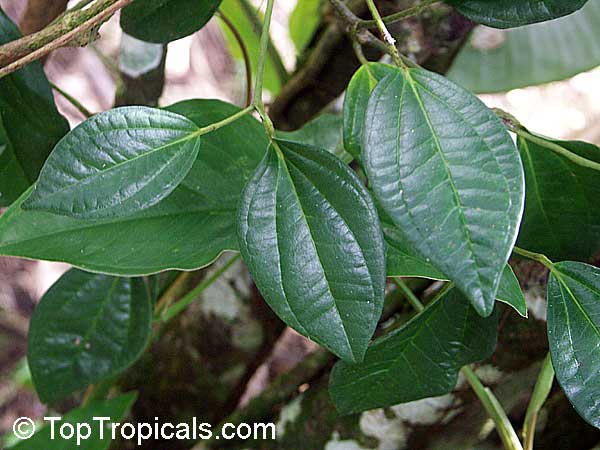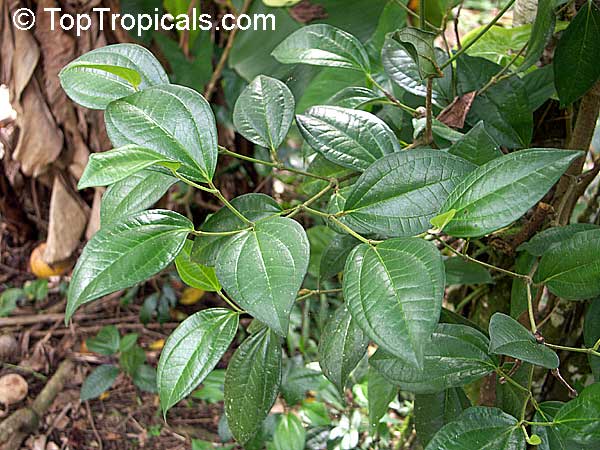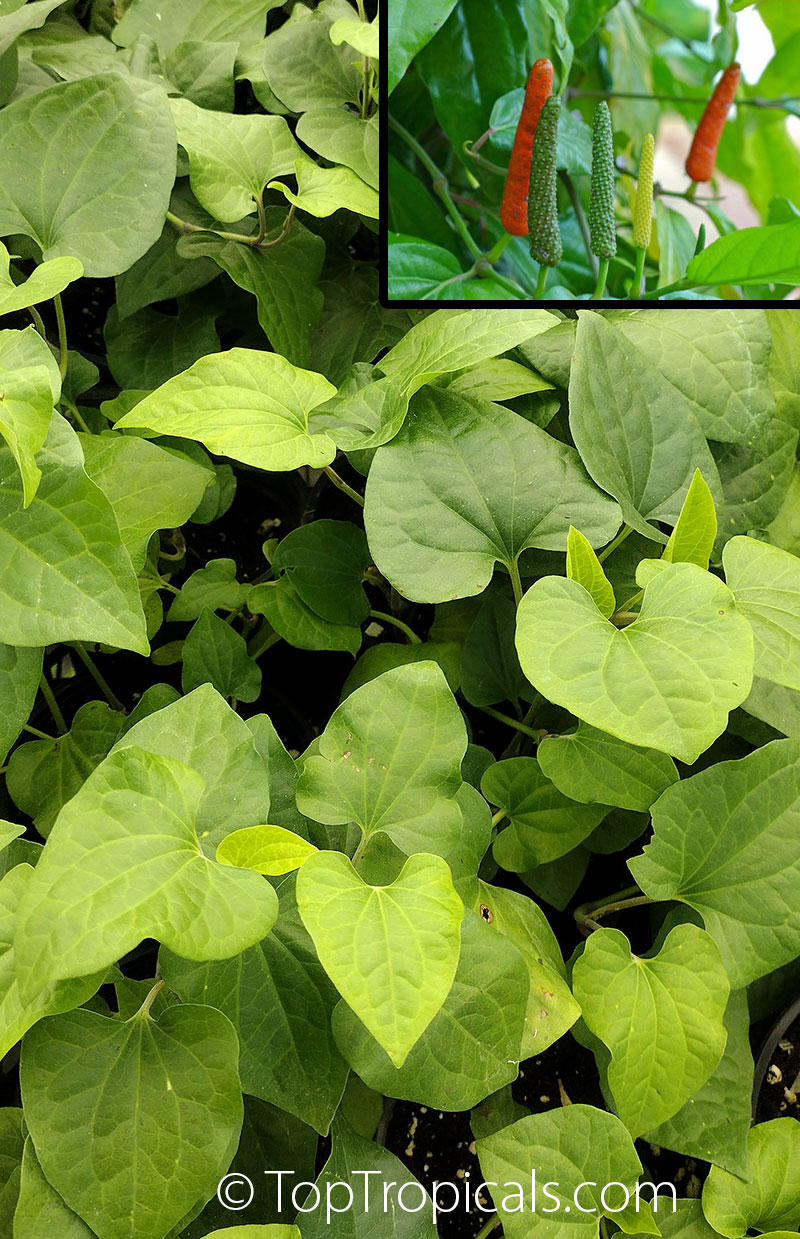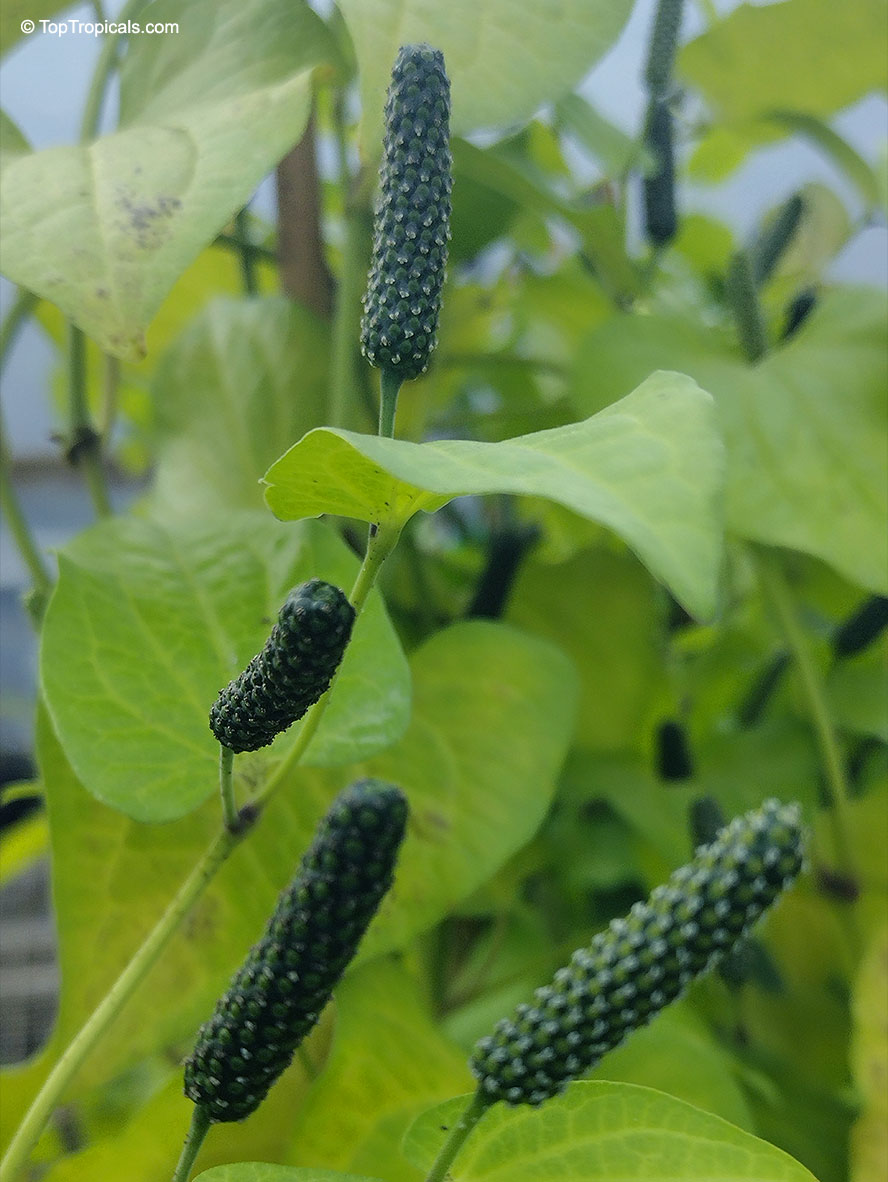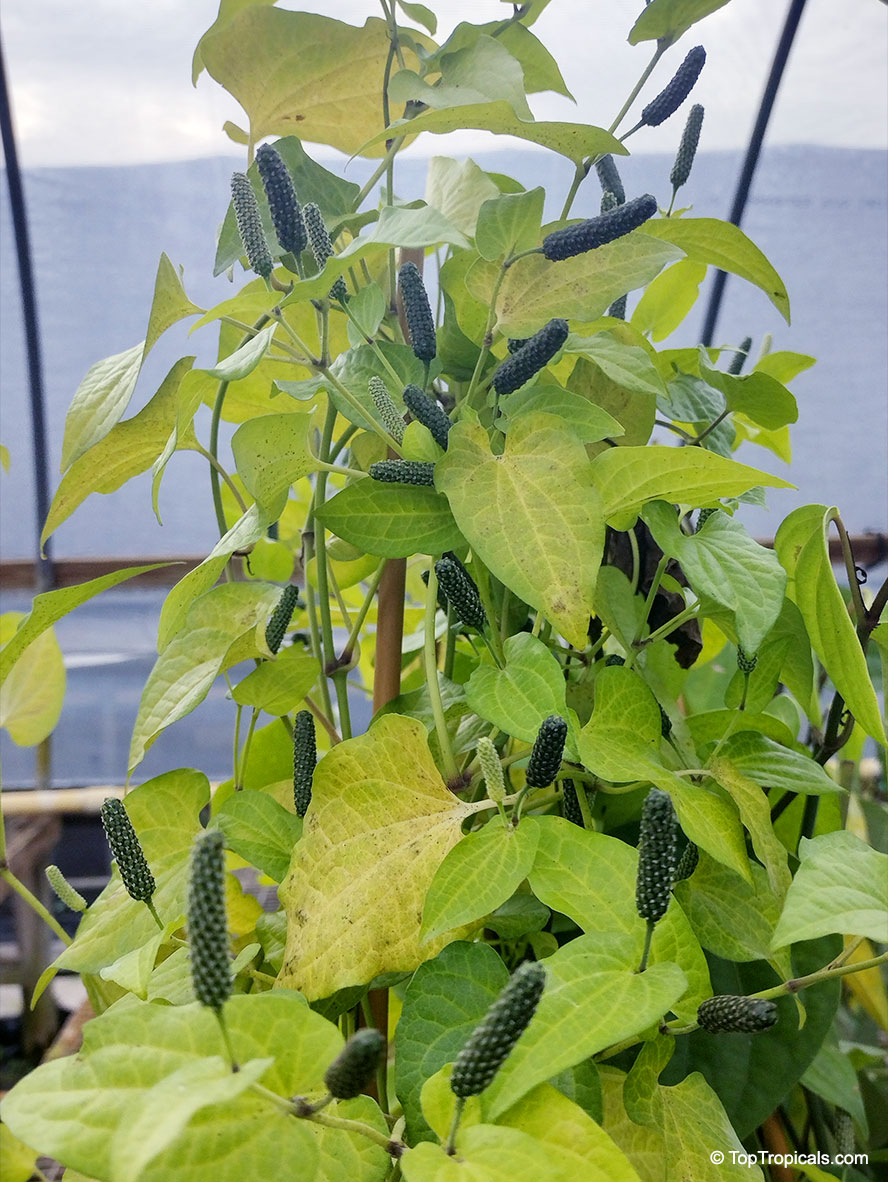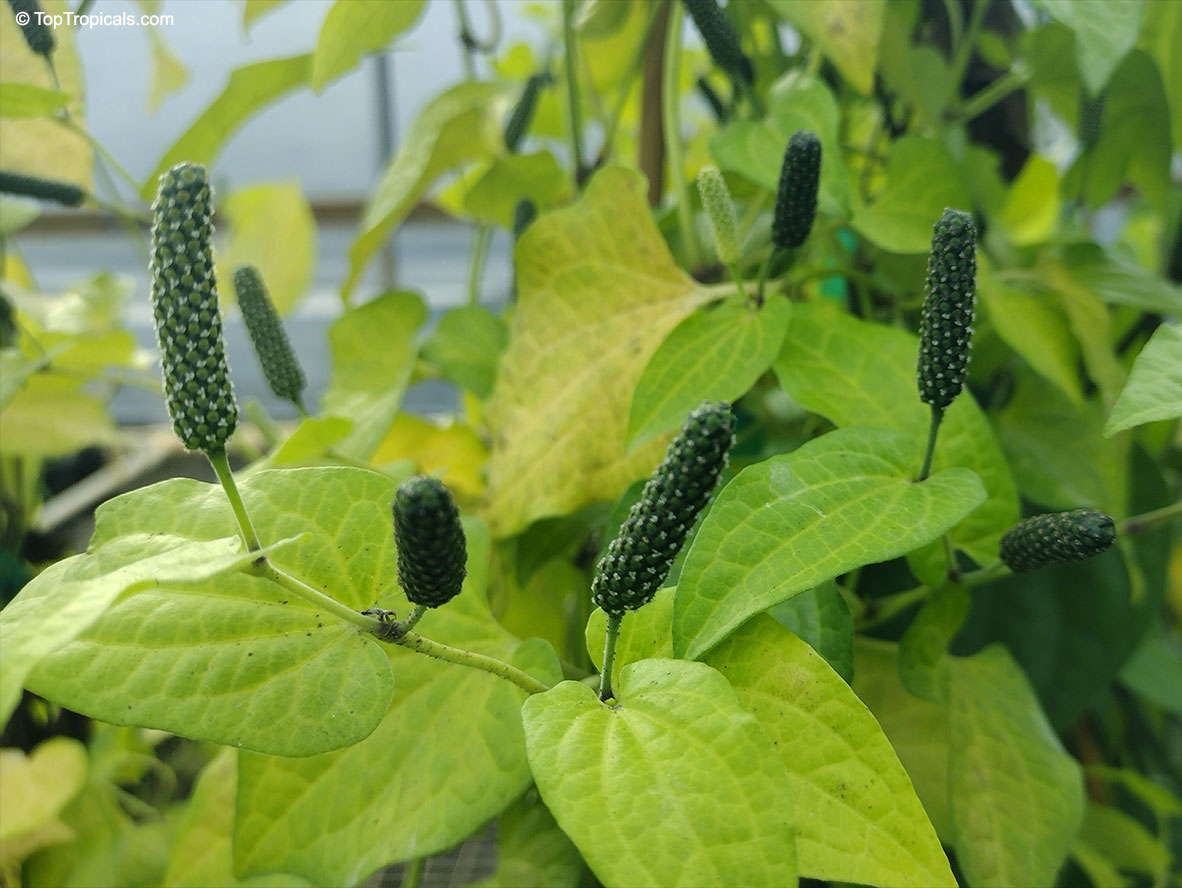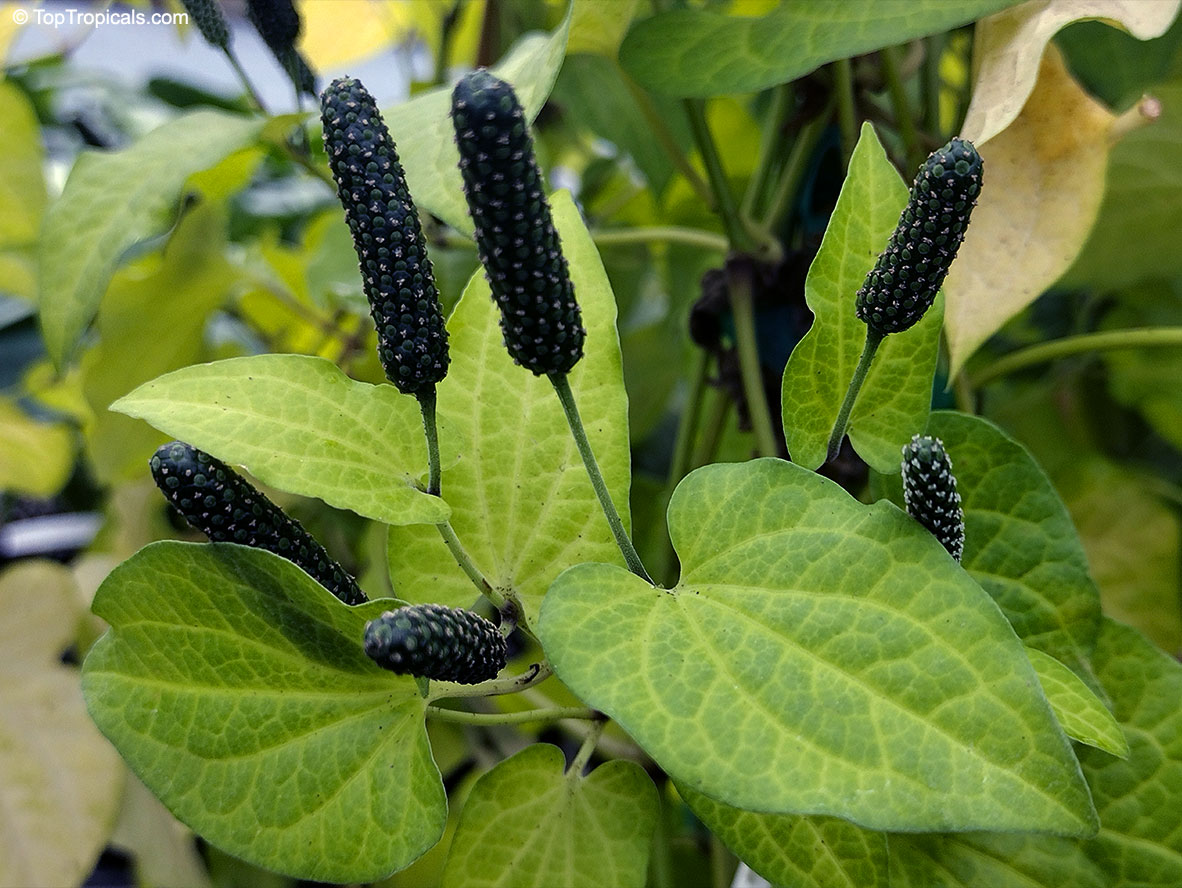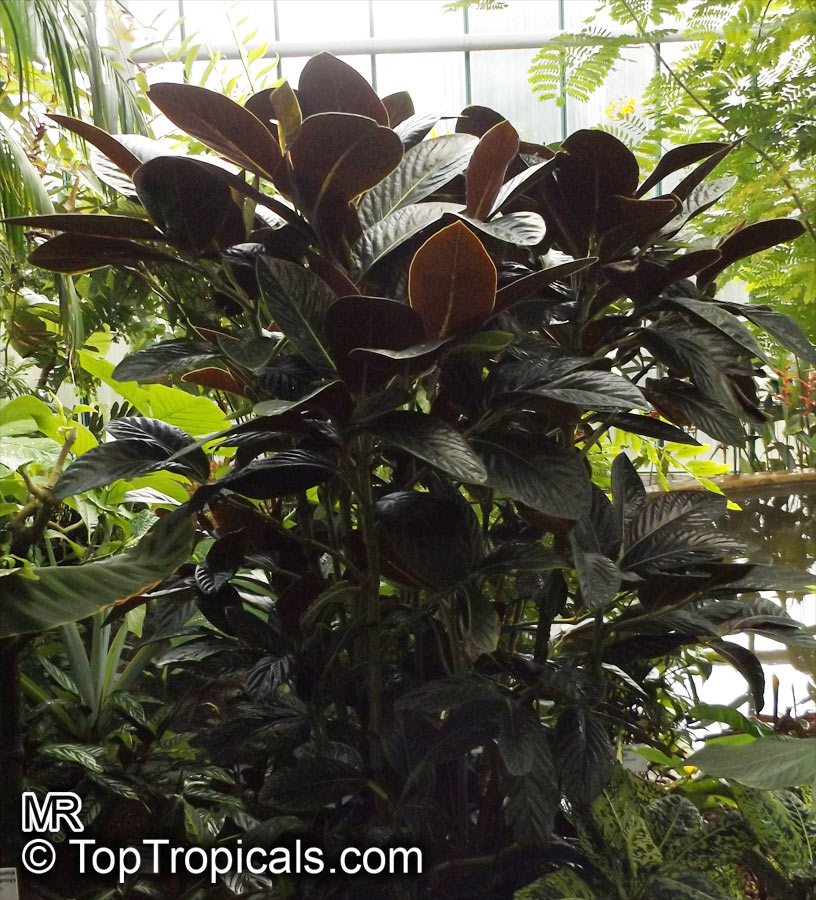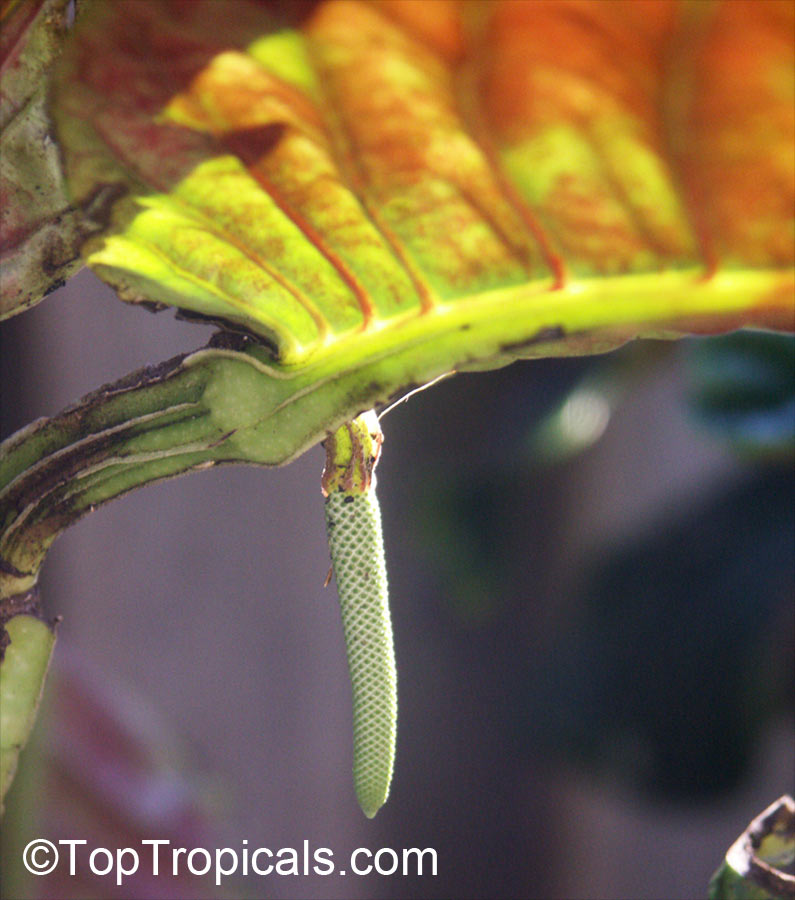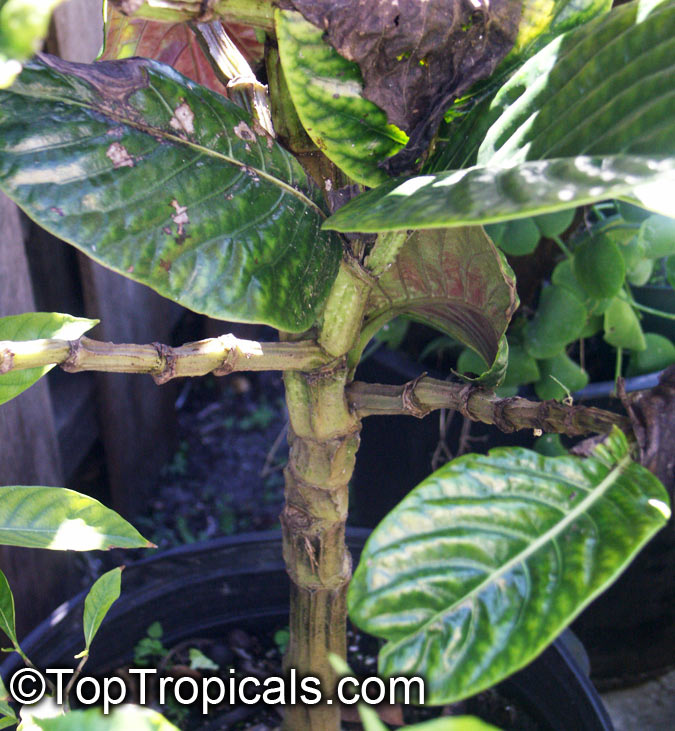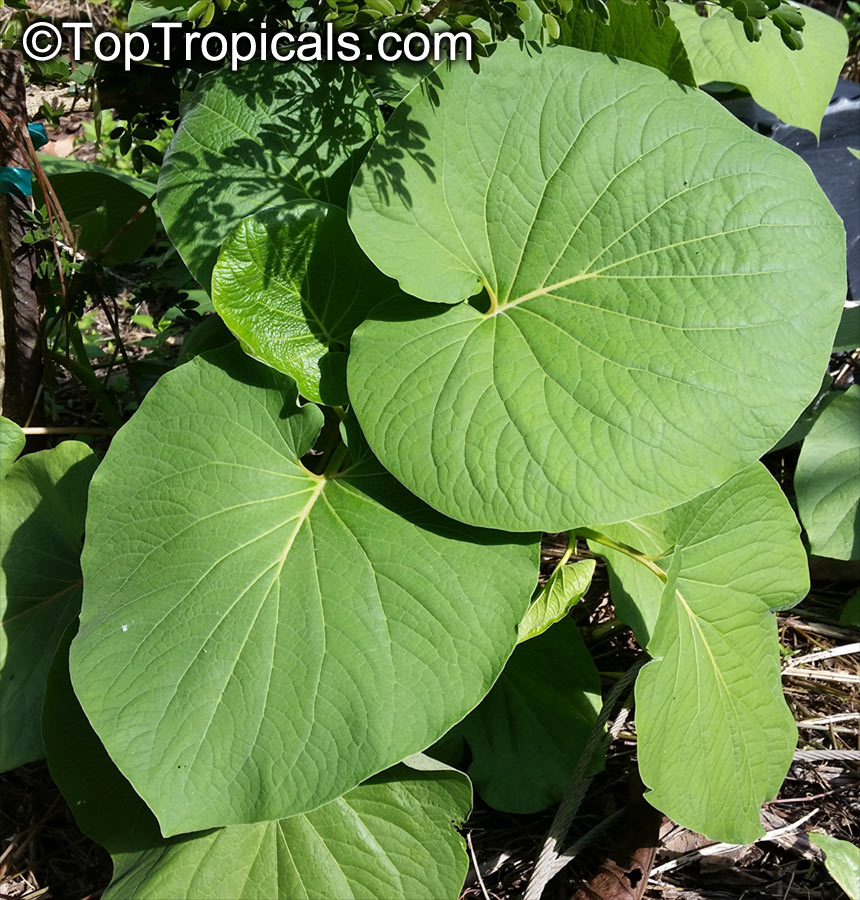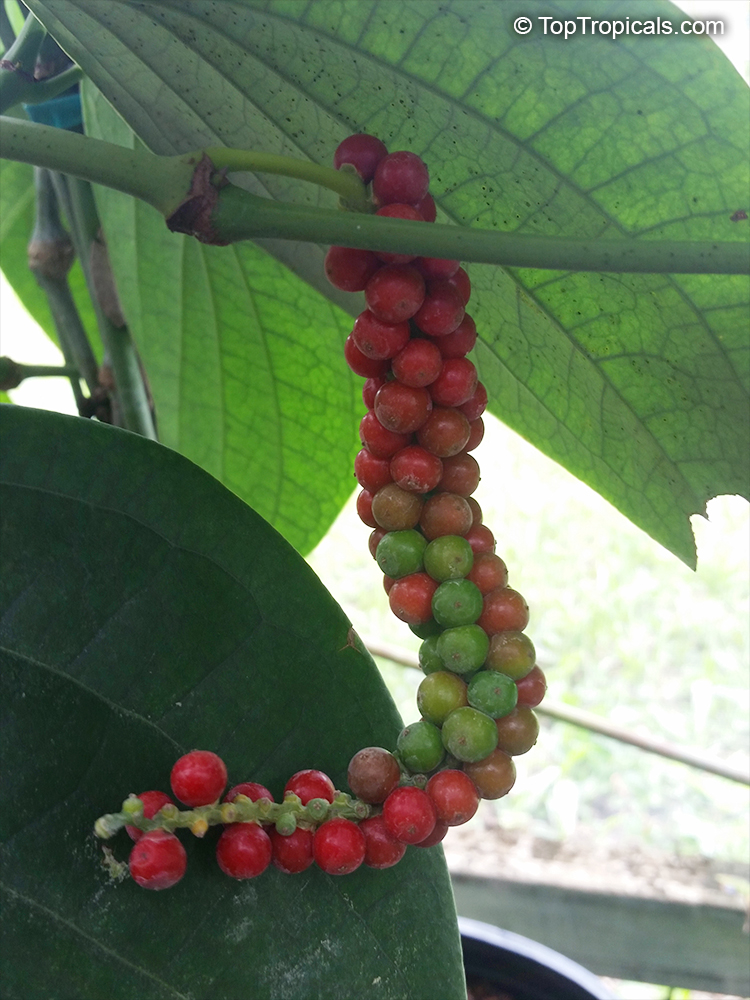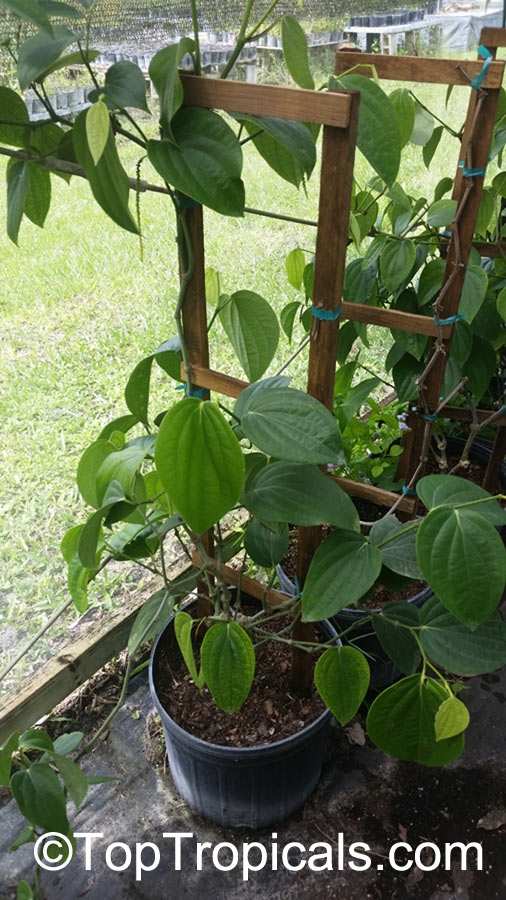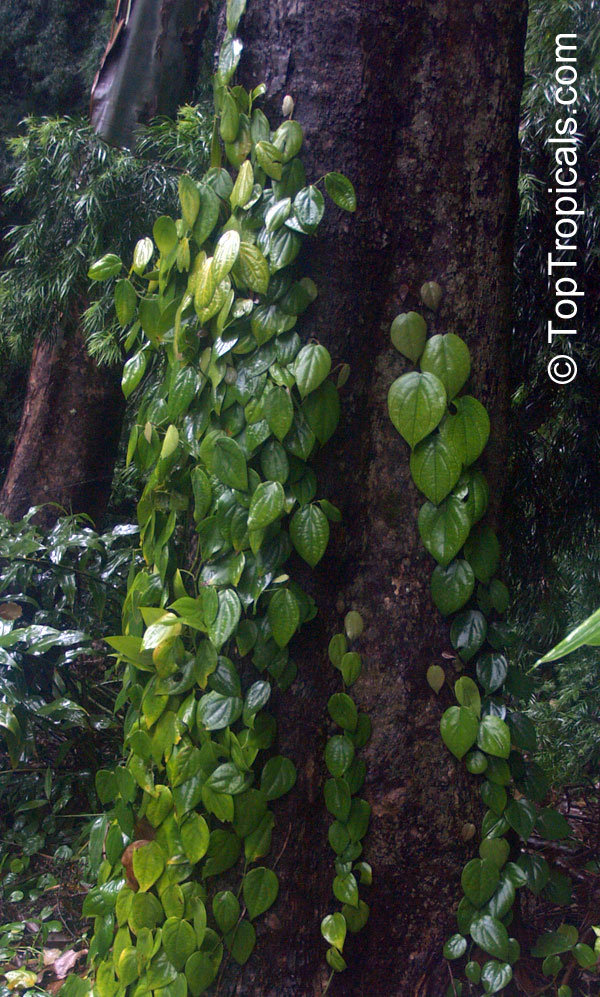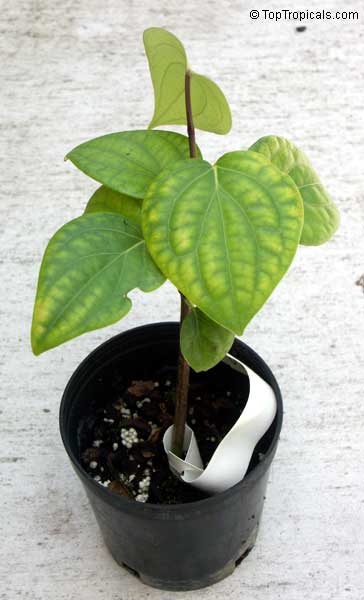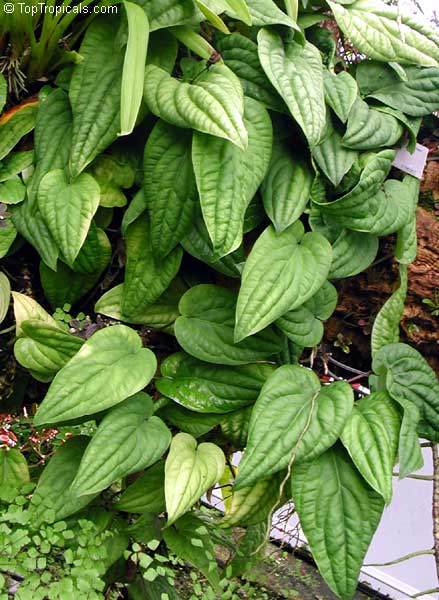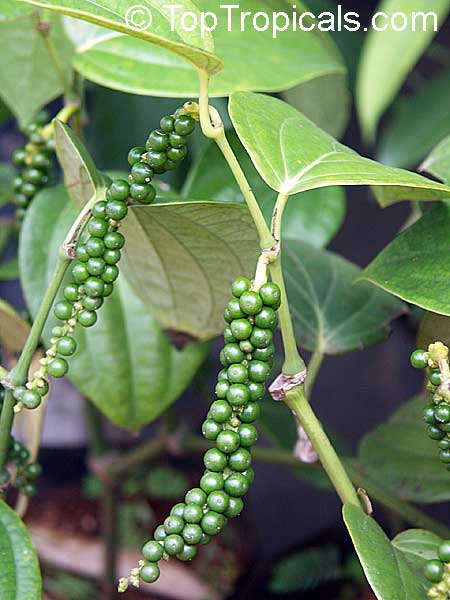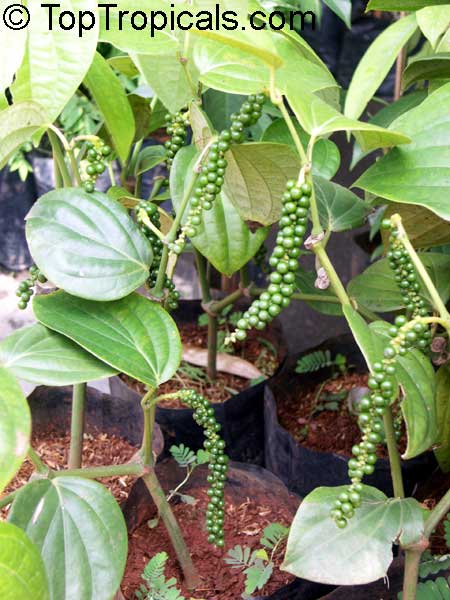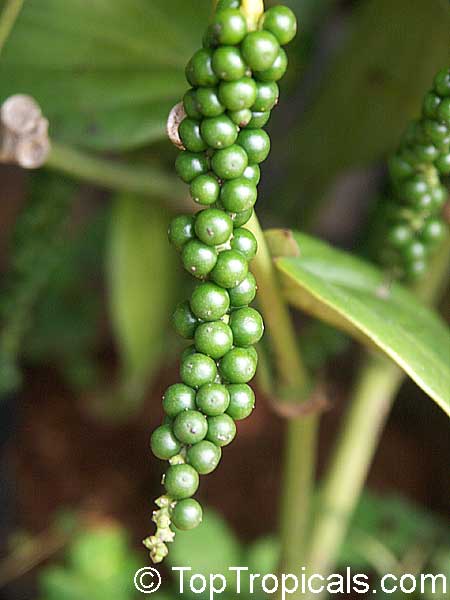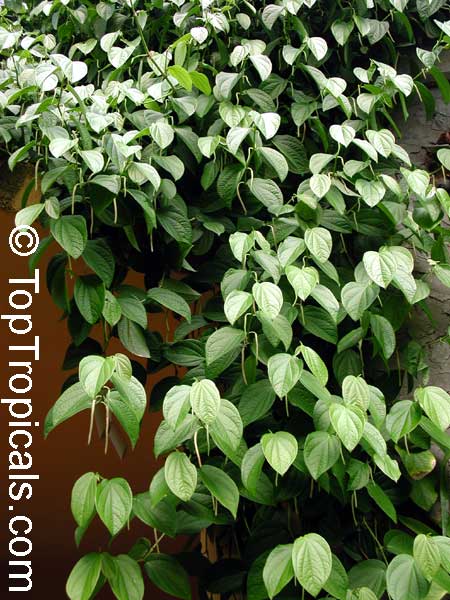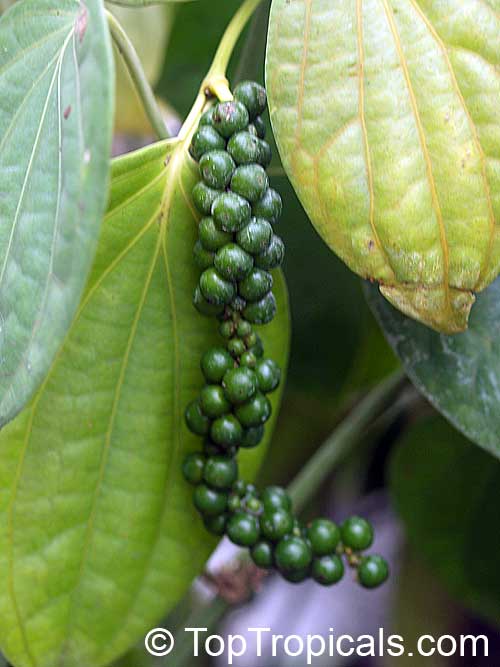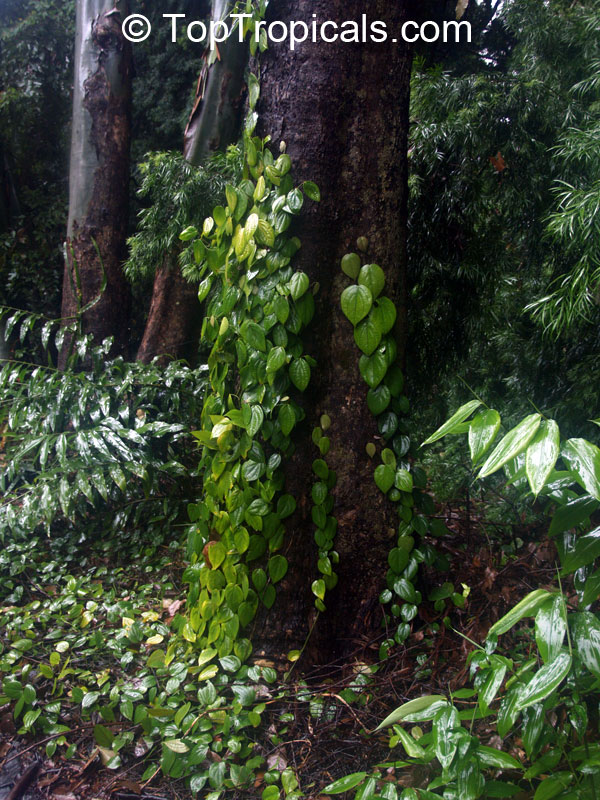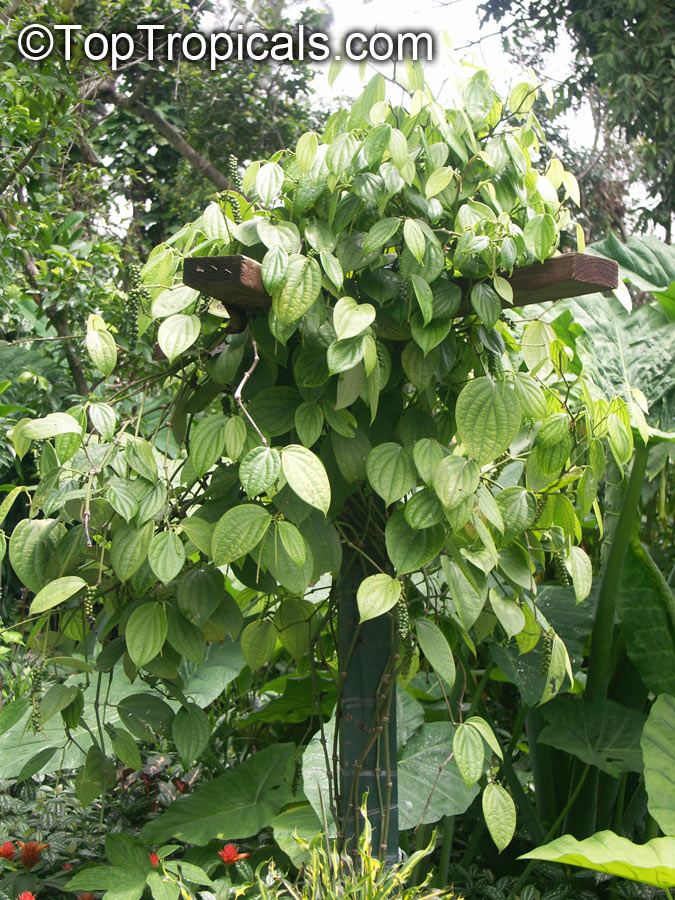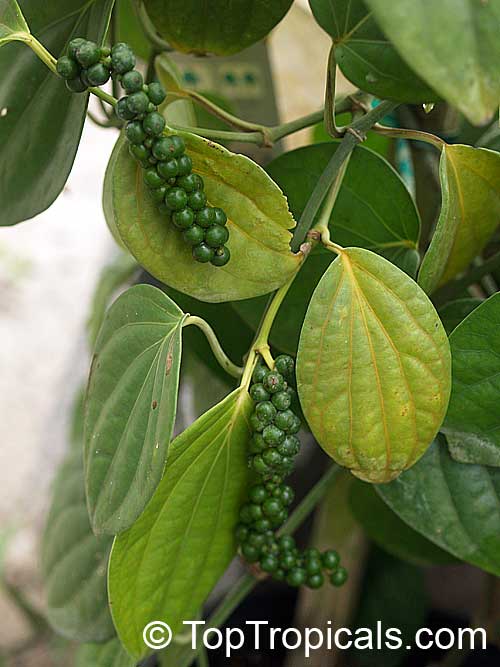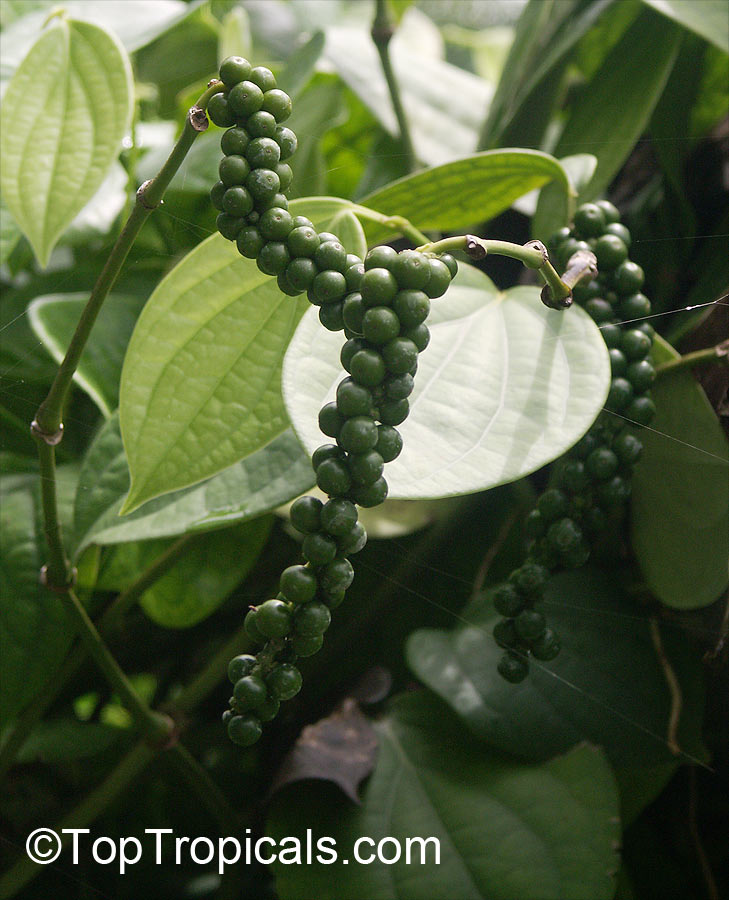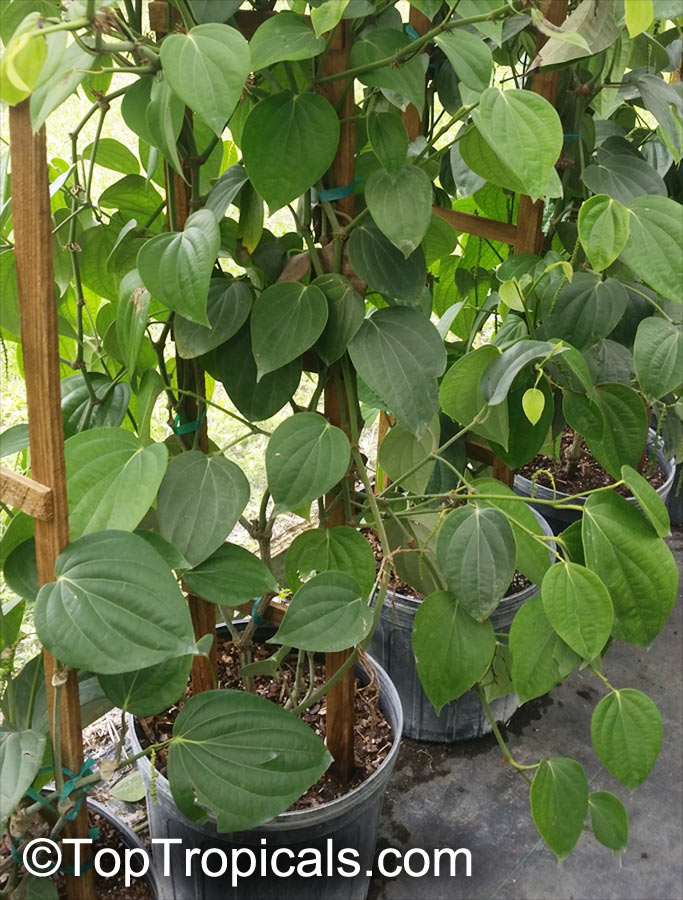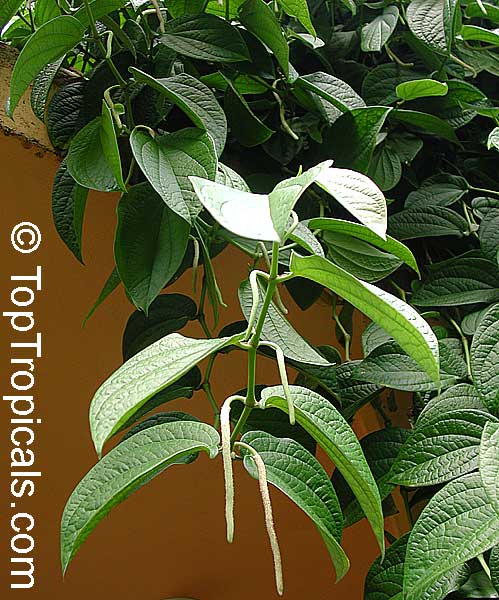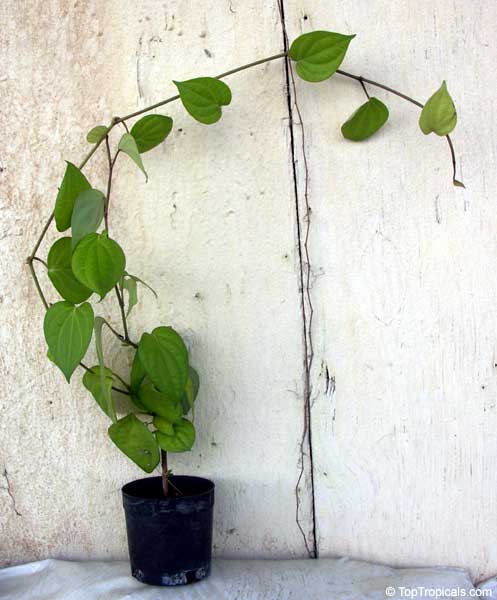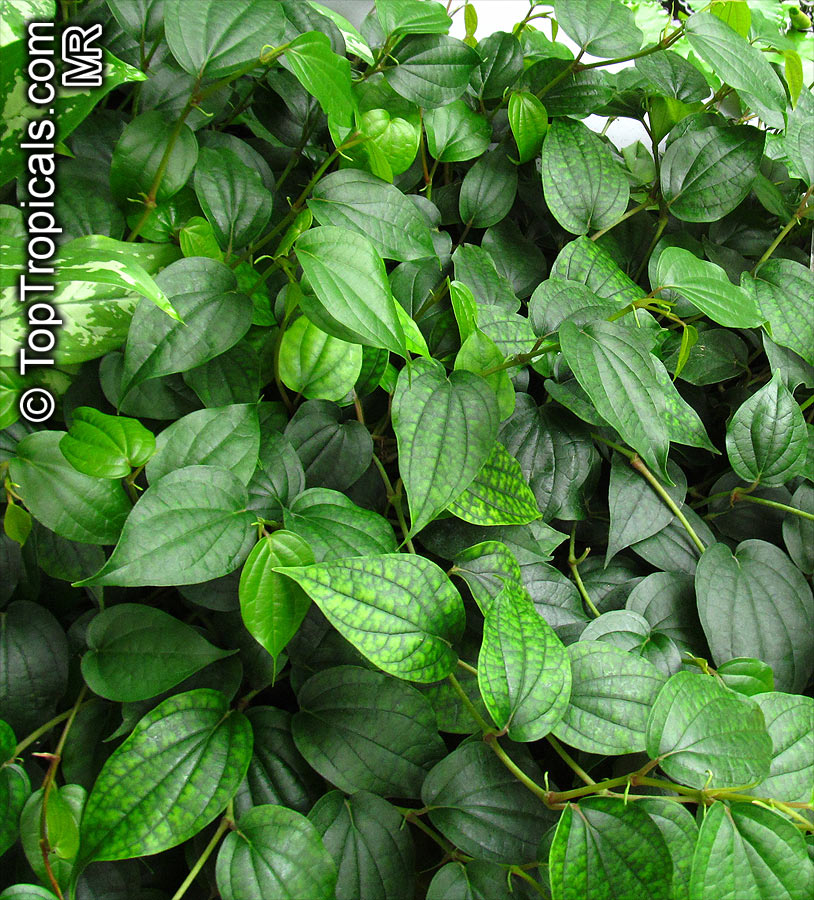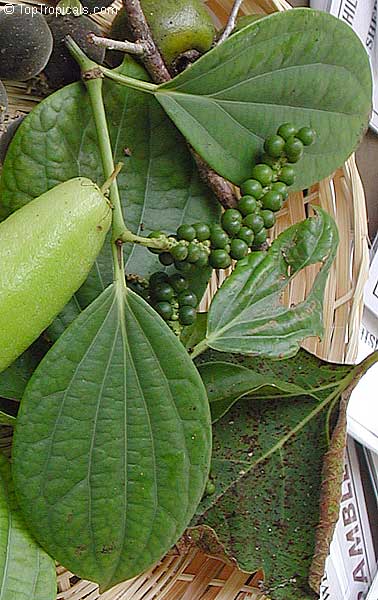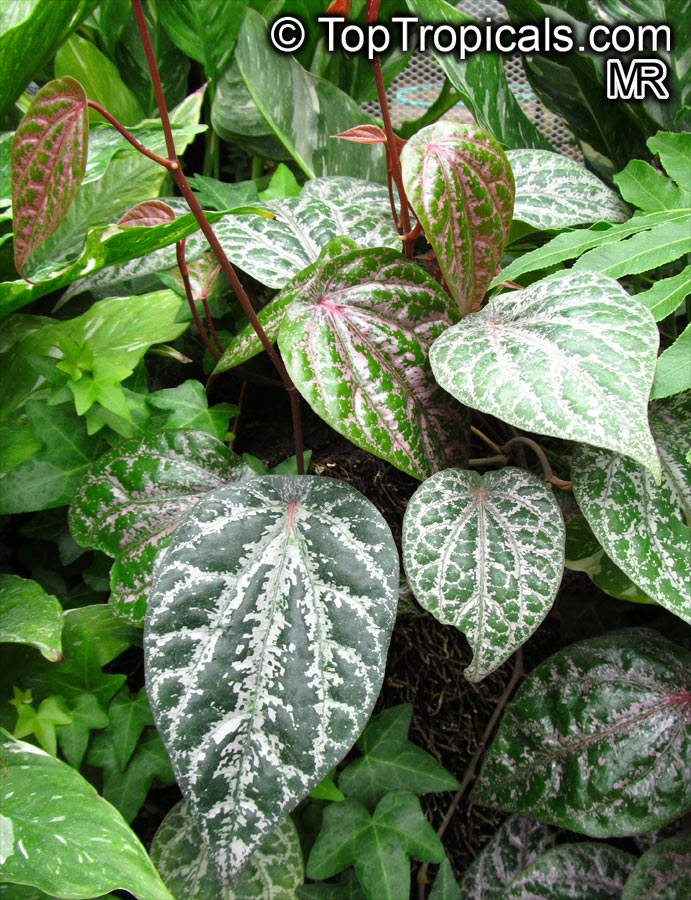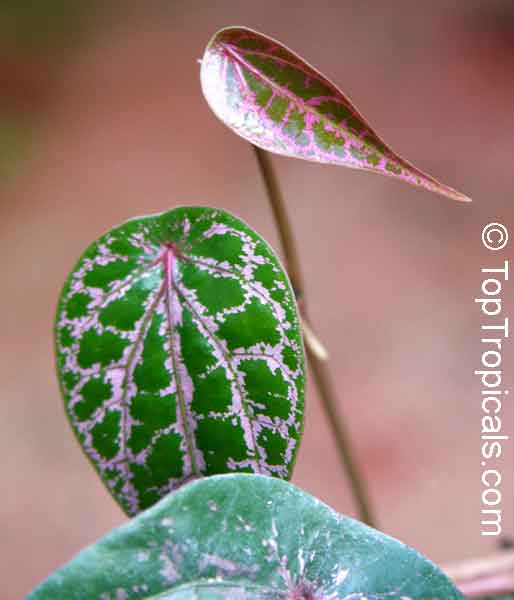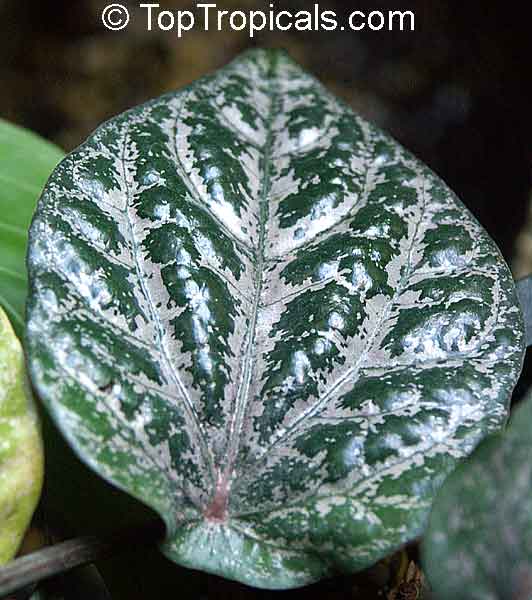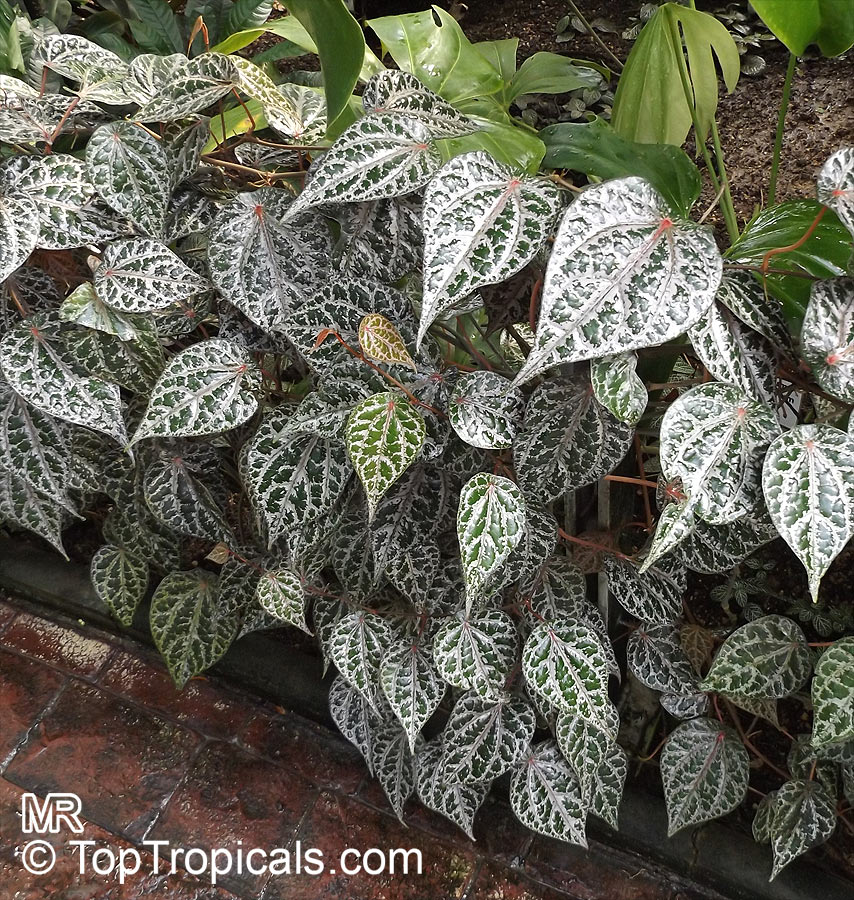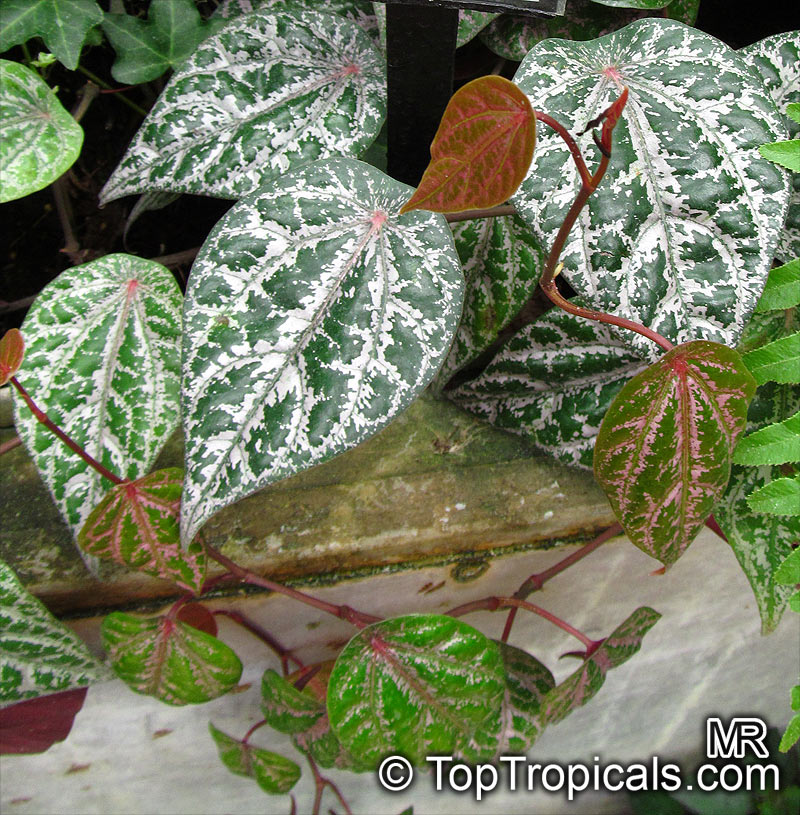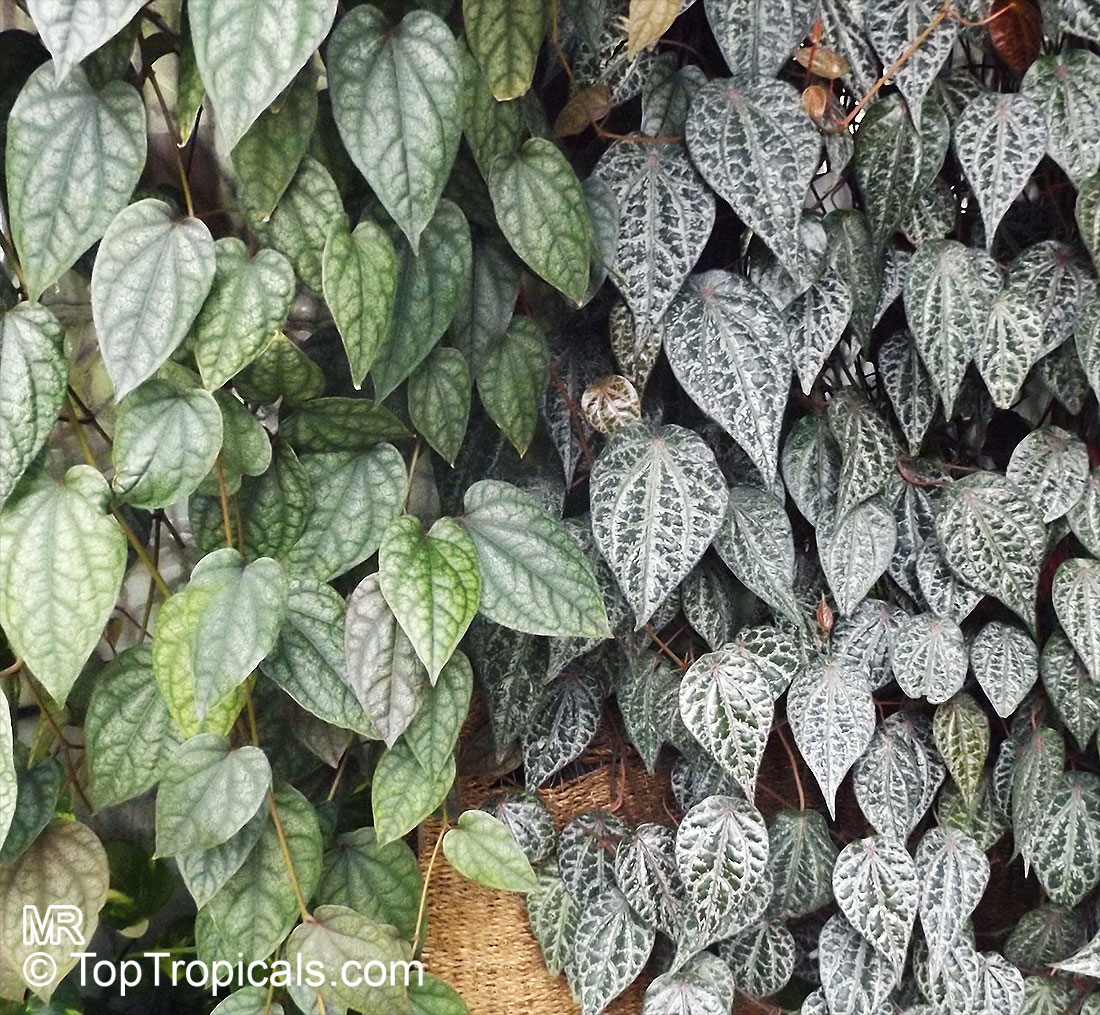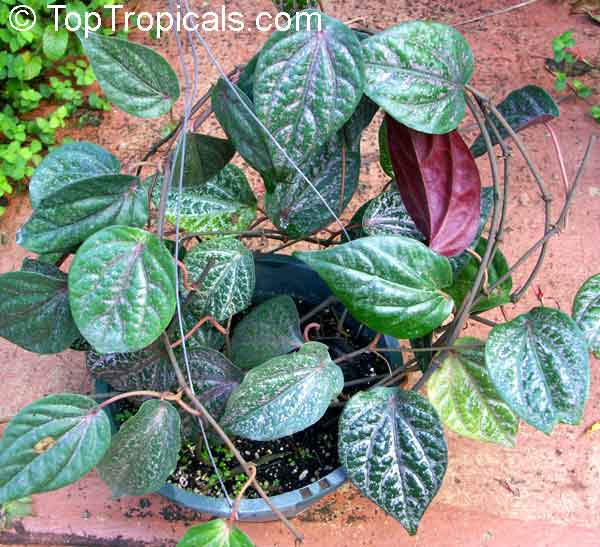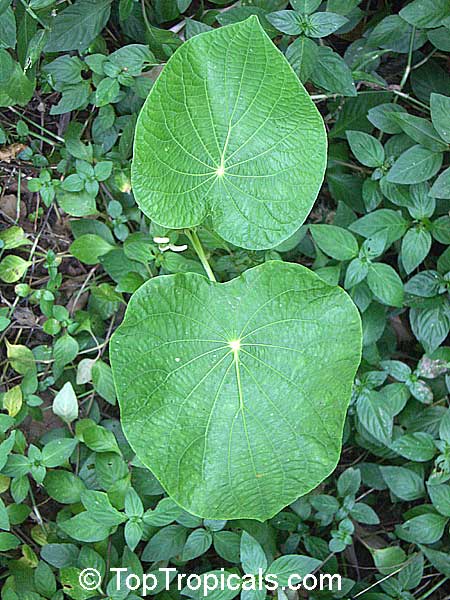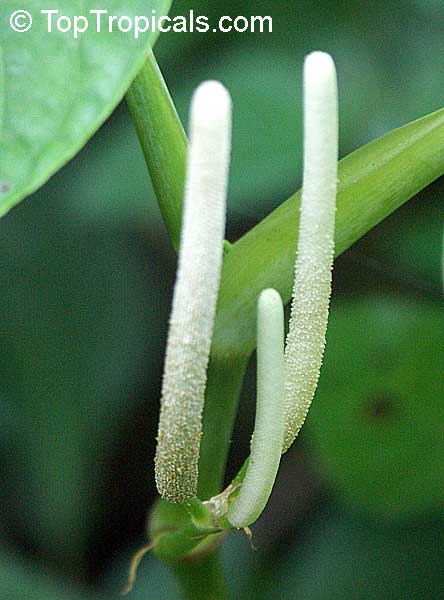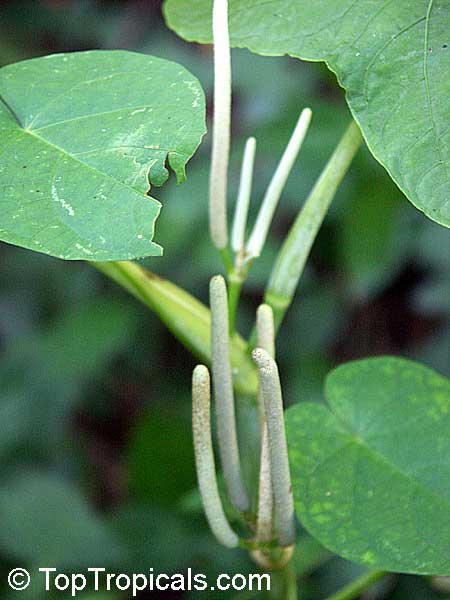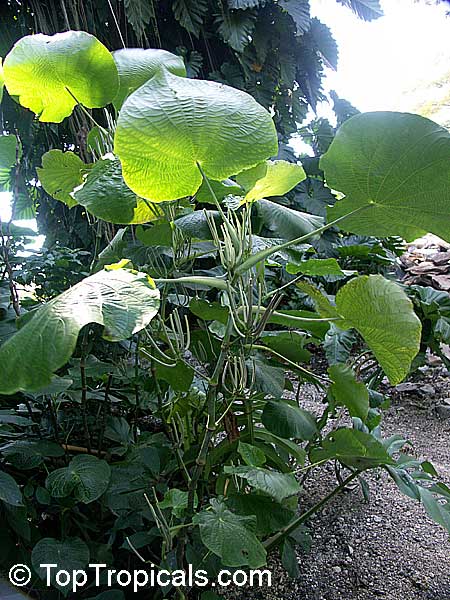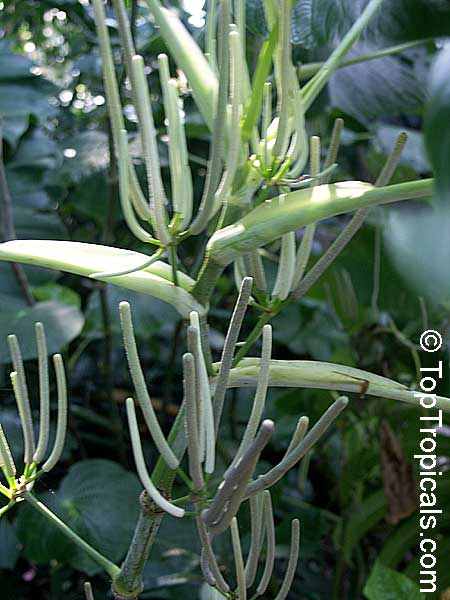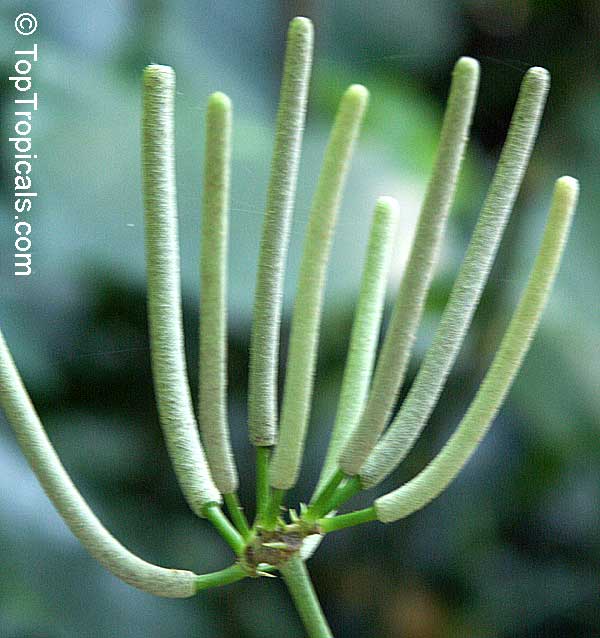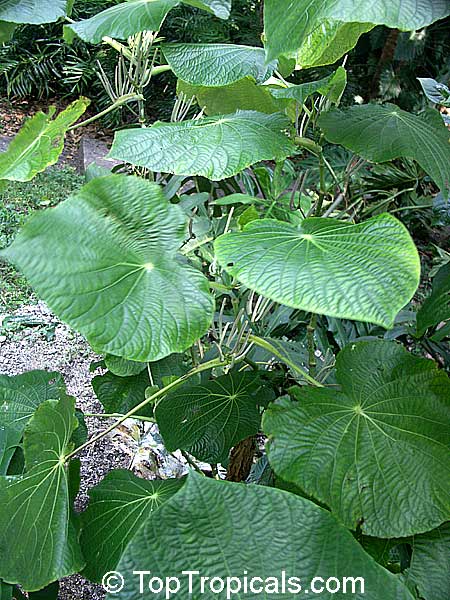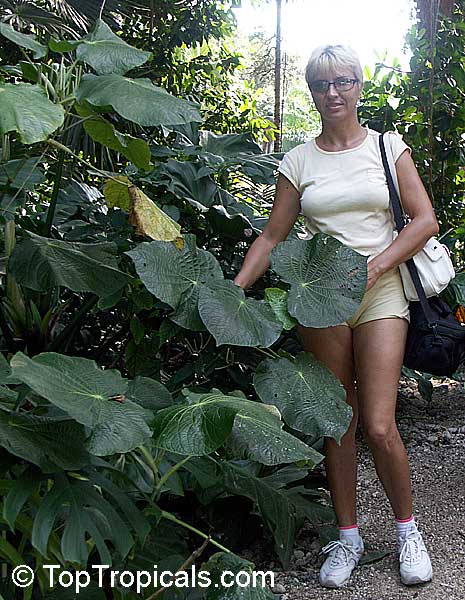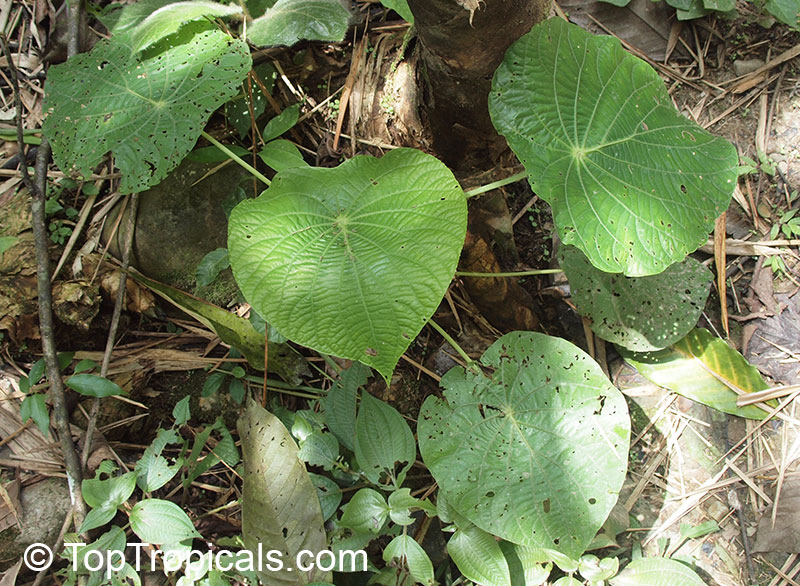Piper - Plant Encyclopedia Results
Top Tropicals Plant Encyclopedia
| Number of plants found: 37 | Next | 
|
Go to page: | 1 | 2 | 3 | 4 |
Botanical names: Piper aduncum, Piper angustifolium, Piper elongatum
Common names: Spiked Pepper, Higuillo de Hoja, Matico
Family: Piperaceae
Origin: South and Central America





Small tree to 7 m tall, with short silt roots and soft, brittle wood; foliage and twigs aromatic. Branches erect, but with drooping twigs and swollen, purplish nodes. Leaves alternate, distichous, elliptic, 12-22 cm long, shortly petiolate; lamina scabrid above, with sunken nerves, softly hairy beneath. Inflorescence a leaf-opposed, curved spike on a 12-17 cm peduncle, white to pale yellow, turning green with maturity. Flowers crowded in regular transverse ranks. Fruit a 1-seeded berry, blackish when ripe.
Used as a aromatic stimulant, against gonorrhea, leukorrhea, piles, hemorrhages and dyspepsia.
Propagation: seeds and cuttings.
Culture: full sun / light shade, sandy loam soil, needs high humidity.
Plant in frost free areas.
Botanical name: Piper auritum
Common names: Root Beer Plant, Mexican Pepperleaf, Hoja Santa , Veracruz Pepper, False Kava-Kava, Sacred Pepper
Family: Piperaceae
Origin: Mexico through Colombia












Close relative of Piper methysticum (Kava-Kava), and Piper nigrum (Black Pepper), this herb originated from Tropical America and grows also in the South Pacific. Large-leaved perennial, known for its leaves, which are used for their spicy aromatic scent and flavor, some liken to root beer, others to anise-clove. This species is easily identified by its huge leaves which can grow over a foot long in older specimens. Plants will grow out from roots so it can spread in ideal conditions. Flowers are long, skinny, white, and fuzzy looking. They may be borne in season. The plant doesn't usually form many fruits outside of its native range. The leaves are chopped and used for flavoring, as well as used whole, as wrappings for meats, tamales, etc.
P. auritum is very often confused with Piper methysticum (Kava-Kava), and probably has some similar effects. According to other sources, it can be poisonous. Explorer Captain James Cook, who gave this plant the botanical name of "intoxicating pepper", first discovered the true kava kava. Kava has been used for over 3,000 years for its medicinal effects as a sedative, muscle relaxant, diuretic, and as a remedy for nervousness and insomnia. It has been used in parts of the Pacific at traditional social gatherings as a relaxant and in cultural and religious ceremonies to achieve a higher level of consciousness. The roots can be made into a mildly narcotic beverage that is comparable to popular cocktails in our culture. Kava is now recognized by many doctors as an alternative to drugs like Xanax and Valium.
See Article about this plant.
Recommended Fertilizer: SUNSHINE Robusta - Rapid Growth Booster
Botanical name: Piper betle
Common name: Betel leaf
Family: Piperaceae
Origin: India









The plant grows widely over the entire area between South Arabia and Southeast China. It is a branching vine, that may climb as high as 10-15ft, although it often grows as an understory ground cover. The plant prefers warm, humid conditions, but can tolerate some drought. It is generally too tender to grow outside of the tropics. It is used in a number of traditional remedies for the treatment of stomach ailments, infections, and as a general tonic. It is often chewed in combination with the betel nut (Areca catechu), as a stimulatory. Some evidence suggests that betel leaves have immune boosting properties as well as anti-cancer properties. The essential oil is produced by steam distillation from the leaves of Piper Betle. Betel Leaf Oil is yellow to brown with an distinctly phenolic, almost tar-like or smoky. Leaves have long been used in Indonesia as traditional medicine. These leaves have antimicrobial activity towards bacteria in the mouth. Essential oils of the plant contained phenolic compounds. Throughout the balmy Asian tropics, great passion is accorded the chewing of the stimulating fruit of the Areca catechu palm known as betel nut. Traditionally prepared by chopping or slicing the areca nut, adding a bit of moistened lime to a Piper betle leaf and wrapping the nuts in ribbon-like strips of leaf to make a small packet known as a buyo. When one visits a household, the host will likely offer one of these buyos as a gesture of hospitality. Workers will often carry small boxes or bags of prepared betel much like the Peruvians carry coca leaves. Piper betle grows as a vigorous vine which is usually supported by a trellis of bamboo poles. The heart-shaped leaves are marvelously pungent and spicy. Makes as interesting container plant.
See Article about Piper.
Recommended Fertilizer: SUNSHINE Robusta - Rapid Growth Booster
Botanical name: Piper longum
Common names: Bengal Pepper, Indian Long Pepper, Pippali, Piplamul
Family: Piperaceae
Origin: South Asia






Long pepper is an edible and medicinal plant used as spice and in traditional Chinese medicine. It is cultivated for its fruit, which is usually dried and used as a spice and seasoning. Long pepper has a taste similar to, but sweeter and less pungent than, that of its close relative Piper nigrum (Black pepper) - from which black, green and white pepper are obtained.
Long Pepper is highly valued medicinal plant with decongestant, bronchodilator and expectorant effects, used to treat respiratory infections, stomachache, bronchitis, diseases of the spleen, cough, and much more.
The plant grows into a vining shrub or a vine that can climp a tree, trellis or fence. Prefers shade to semi-shade and adequate water. The leaves of Piper longum start as heart shaped in juvenile plants and may get more elongated as the plant matures.
The species Piper longum is of South Asian origin (Deccan peninsular), whereas the closely related Piper retrofractum
comes from South East Asia and is mostly cultivated in Indonesia and Thailand.
See Article about Pipers.
Long Pepper is highly valued medicinal plant with decongestant, bronchodilator and expectorant effects, used to treat respiratory infections, stomachache, bronchitis, diseases of the spleen, cough, and much more.
The plant grows into a vining shrub or a vine that can climp a tree, trellis or fence. Prefers shade to semi-shade and adequate water. The leaves of Piper longum start as heart shaped in juvenile plants and may get more elongated as the plant matures.
The species Piper longum is of South Asian origin (Deccan peninsular), whereas the closely related Piper retrofractum
See Article about Pipers.
Recommended Fertilizer: SUNSHINE Robusta - Rapid Growth Booster
Botanical name: Piper magnificum
Common name: Lacquered Peppertree
Family: Piperaceae
Origin: South America




With its rounded habit, Piper magnificum assumes an upright and stately look that gives the impression of a dome, or umbrella shaped shrub. It reaches a maximum height of 5-10 ft, with a spread of 7-12 ft, and it thrives best in areas that experience semi-shady sunlight.
When planting, water thoroughly and regularly to keep the soil from drying out. This plant needs moderate water and will do well in most soils, as long as it is well-draining and is reaching a full sun position. It will tolerate short periods of drought. To achieve the best shape and abundant blooms, prune the lacquered peppertree at least once a year.
The Piper magnificum is a USDA Zone 9-11 plant, that requires more attention during cold months. When planting in a pot, make sure to protect it from the cold weather by moving it close to your home, or to a sheltered spot in your garden. Place the pot in a sunny position, limiting direct exposure to sun during the hottest parts of the day, and keep its roots before temperatures drop. During winter, cover the pot with plastic sheeting or mulch. Water regularly, but make sure it is not overwatered.
To maximize flowering, youcan apply fertilizer to the soil every 4-6 weeks, or top up existing mulch with fresh mulch each spring. To keep it clean and attractive, prune away any dead branches, and pinch the stems that are out of shape. Keep an eye out for aphids or whiteflies, and gargle any encroaching weeds.
With minimal effort, you will be rewarded with a fiercely beautiful Piper magnificum, a large shrub that has a rounded and stately look that adds a natural charm to every garden.
Botanical name: Piper methysticum
Common names: Kava, Kava-Kava
Family: Piperaceae
Origin: Western Pacific




Kava is both the common name and the beverage made from the root of Piper methysticum (family Piperaceae). Kava is native to Oceania, the islands of the tropical Pacific Ocean, where it is used as a ritual drink.
This is a shrub about 6 feet high. The leaves are alternate, cordate, with a wavy, entire margin, and an abrupt, acute point. The petiole is about an inch long, dilated at the base, and furnished with linear, erect stipules. The veins are prominent, about 12, diverging from the base of the leaf-blade. The flowers are small, apetalous, and arranged on slender spikes. Those bearing male flowers are axillary and solitary. The female spikes are numerous. Female flowers are especially rare and do not produce fruit even when hand-pollinated. Its cultivation is entirely by propagation from stem cuttings.
Kava is consumed throughout the Pacific Ocean cultures of Polynesia, including Hawaii, Vanuatu, Melanesia and some parts of Micronesia for its sedating effects. Kava is an anxiolytic herbal medicine used in the treatment of sleep and anxiety disorders. Some cases of kava-induced hepatotoxicity have been reported in the literature leading to its banishment in most countries worldwide.
Botanical name: Piper nigrum
Common name: Pepper
Family: Piperaceae
Origin: Malabar, a region in the Western Coast of South India









Pepper is cultivated since millennia. The wild form has not yet been unambigously identified, but there are closely related pepper species in South India and Burma. While black and white pepper were already known in antiquity, but green pepper (and even more, red pepper) is a recent invention. Black pepper, grown in Southern India since more than two thousand years, has always been much valued all over the world. Pungent and aromatic. The pungency is strongest in white pepper and weakest in green pepper, while black and green pepper are more aromatic than the white one.
See Article about Piper.
See Article about this plant.
Recommended Fertilizer: SUNSHINE Robusta - Rapid Growth Booster
Botanical names: Piper ornatum, Piper crocatum
Common name: Celebes pepper
Family: Piperaceae
Origin: Indonesia





Piper ornatum (Celebes pepper) is an ornamental plant native to Indonesia. It has a unique and eye-catching foliage, making it an excellent ground cover or low-growing vine in any sunny to semi-shade garden. It will grow in USDA zones 9-11 and prefers regular watering. This plant is not fussy with soil types, as long as it is planted in well-draining soil. Fertilize in spring with a balanced fertilizer and prune the stems, if needed, to keep the shape attractive. In colder climates, Piper ornatum may be grown in pots, as long as the roots are kept cool in the winter. Cold weather can cause leaf curling and stem dieback. If you're it growing in a pot, use a good quality potting mix and position in a partially shaded spot.
In the garden, it's an attractive and distinctive groundcover and low-growing vine that grows to about 2 ft (60 cm) in height. Its stunning foliage of heart-shaped leaves, in shades of green, pink and silver is complemented by clusters of white, tubular flowers in mid-summer. The undersides of the leaves are a striking purple-red shade that gives it an even more eye-catching appearance.
Piper ornatum is a great choice for any sunny to semi-shade garden and is low maintenance in terms of care. It requires regular watering and fertilizing. In colder climates, this plant can be successfully grown in pots, provided the roots are kept cool in the winter. The best soil type is well-draining, but it is not fussy. Prune stems, if needed, to keep the plant attractive.
Botanical names: Piper peltatum, Lepianthes peltata, Pothomorphe peltata
Common names: Pakina, Monkey's Hand, Santa Maria Plant, Cachimuela, Cordoncillo, Pariparoba, Pariparova, Jaguarandi, Capeba, Caena
Family: Piperaceae
Origin: Central America





Piper peltatum is a small plant, typically ranging 2-5 ft in height, with heart-shaped glossy green leaves. The stems are woody and usually not more than an inch in diameter. When used for ethnomedical purposes, the leaves and stems are boiled for about 20 minutes and the resulting liquid is drunk.
The plant thrives in full sun with regular water and is native to Central America. In the United States, it is hardy to USDA Zones 9-11, but may even survive in Zone 8 with protection from the cold in winter. It can also be grown in pots in colder climates, provided the soil does not freeze and the pot is brought in during the winter months.
When planting Piper peltatum, its ideal conditions should be taken into consideration. The soil should be kept moist, but not too wet, to prevent any root rot. Pruning is also beneficial since it helps promote a bushy, healthy form and encourages flowering. Fertilizing is recommended twice a year with a balanced organic fertilizer. As a small shrub, Piper peltatum looks best when kept in a neat and tidy appearance, so regular trimming is necessary to keep it looking good.
With its dual purpose of both ornamental and medicinal benefits, Piper peltatum will make a great addition to any garden. Its bright green foliage, low maintenance, and evergreen qualities makes it a perfect fit for any garden.
| Next |  |
Use link to repeat this search:
https://toptropicals.com/cgi-bin/garden_catalog/cat.cgi?find=Piper&search_op=and&keyword_op=and&language=e&number=10
&no_change_lang=1&user=tt&sale=1&first=0
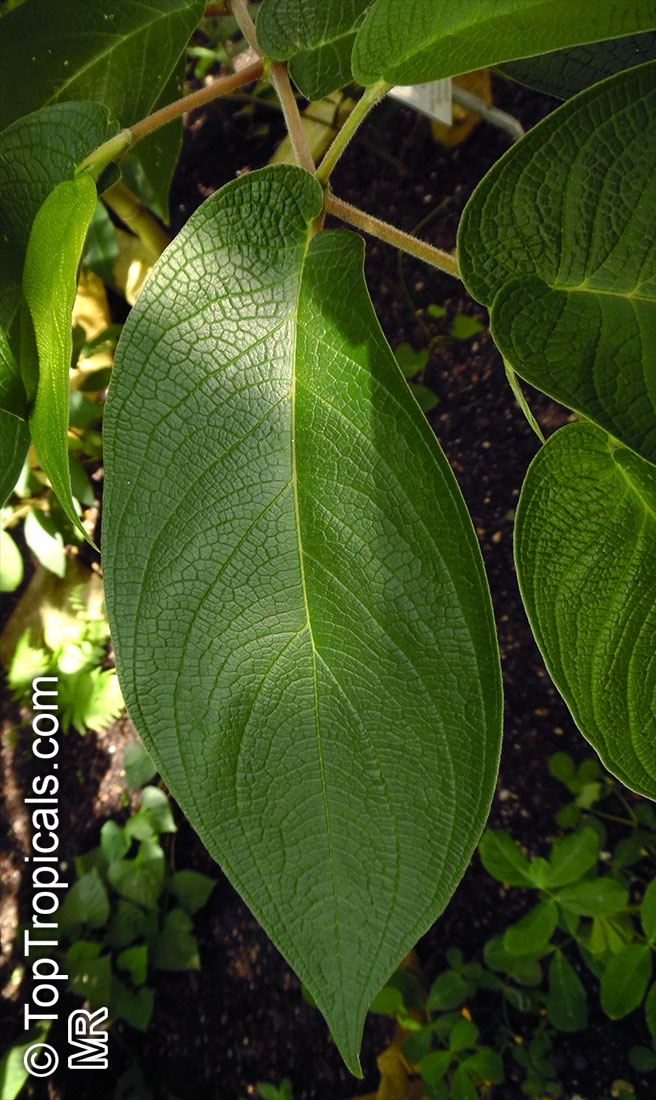
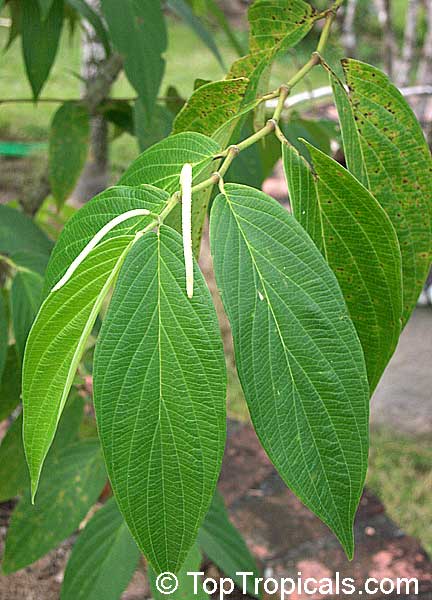
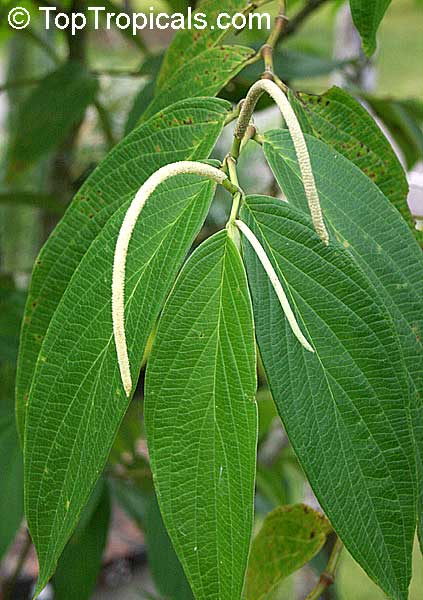
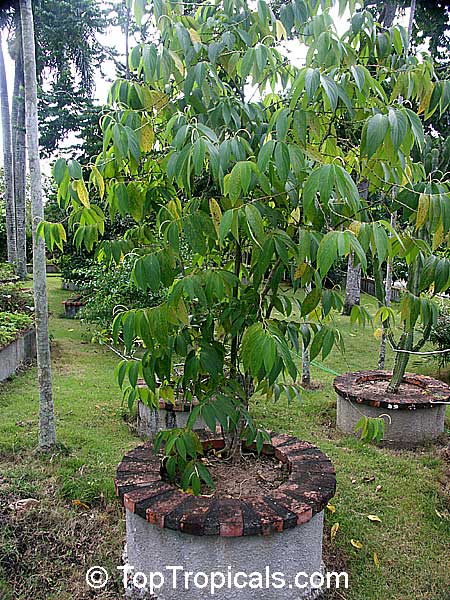
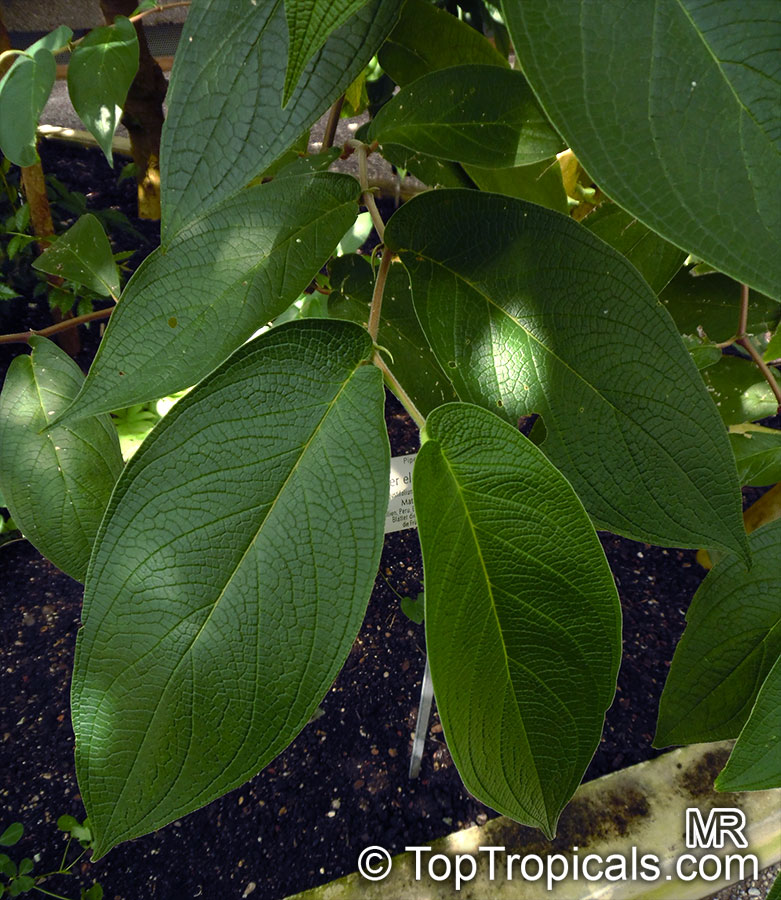
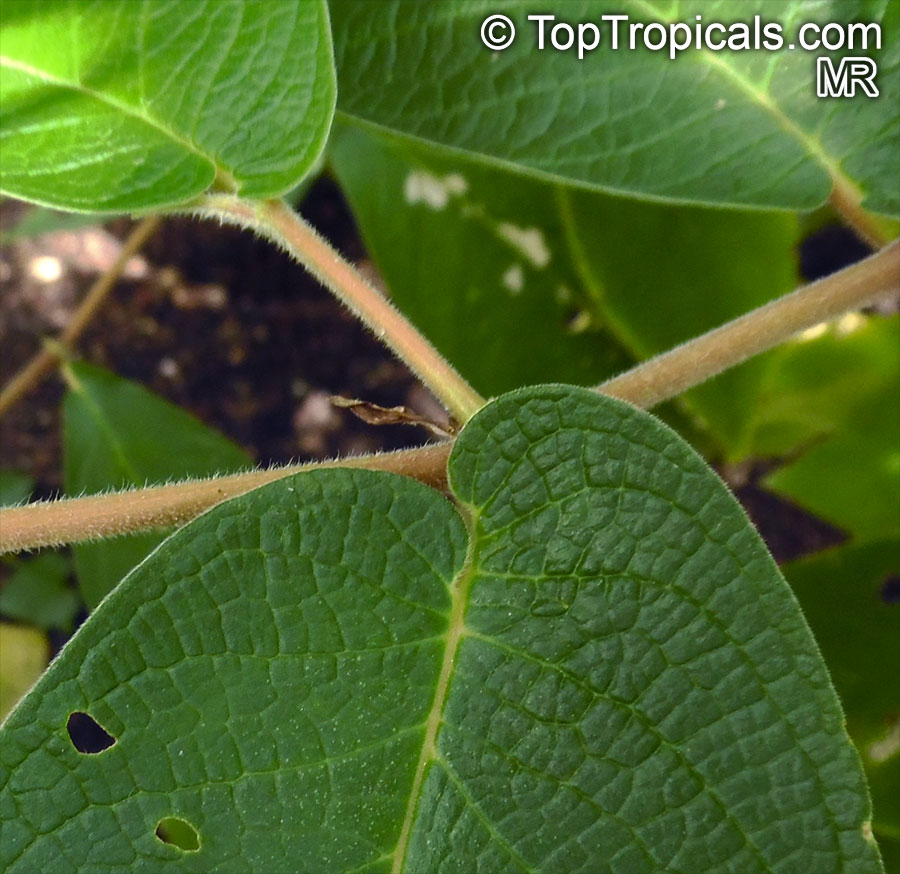

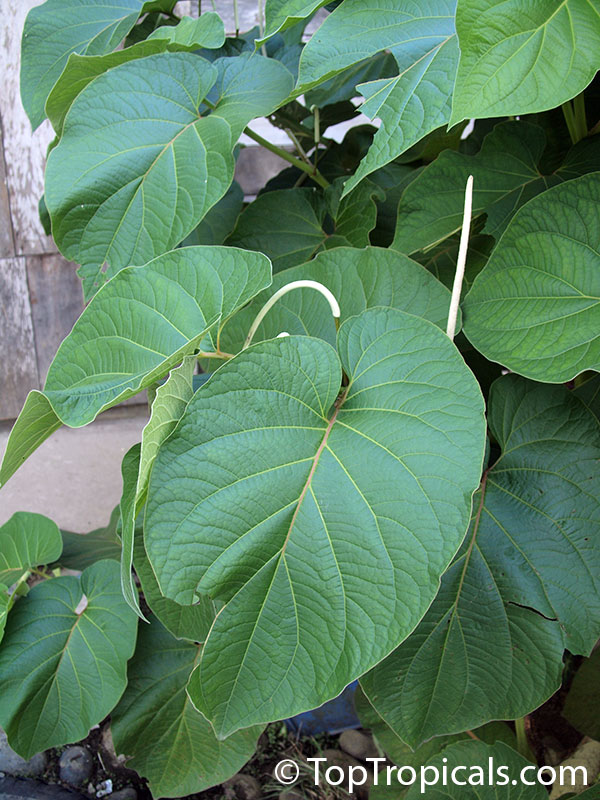
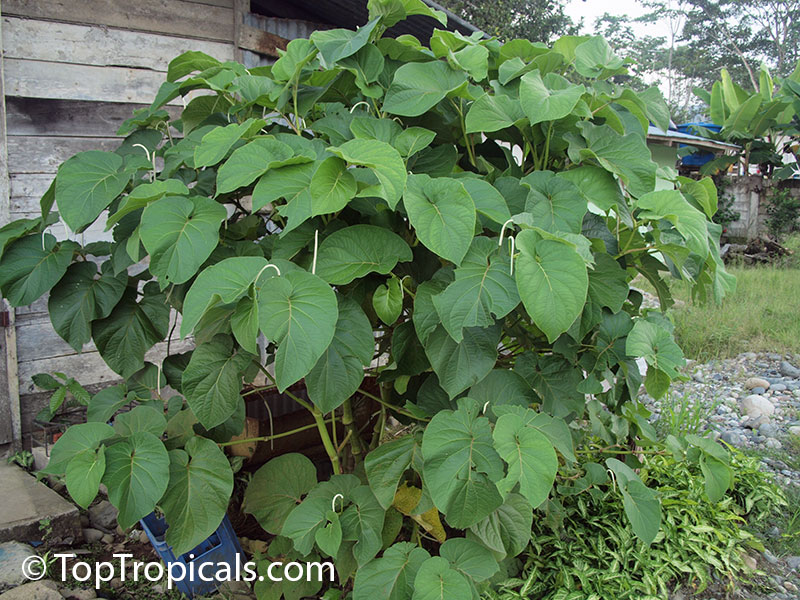
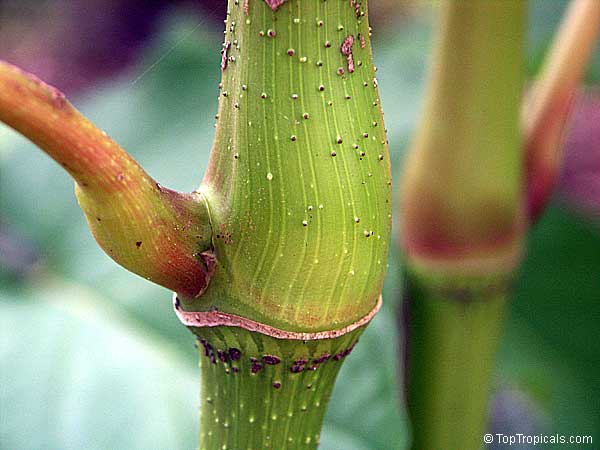
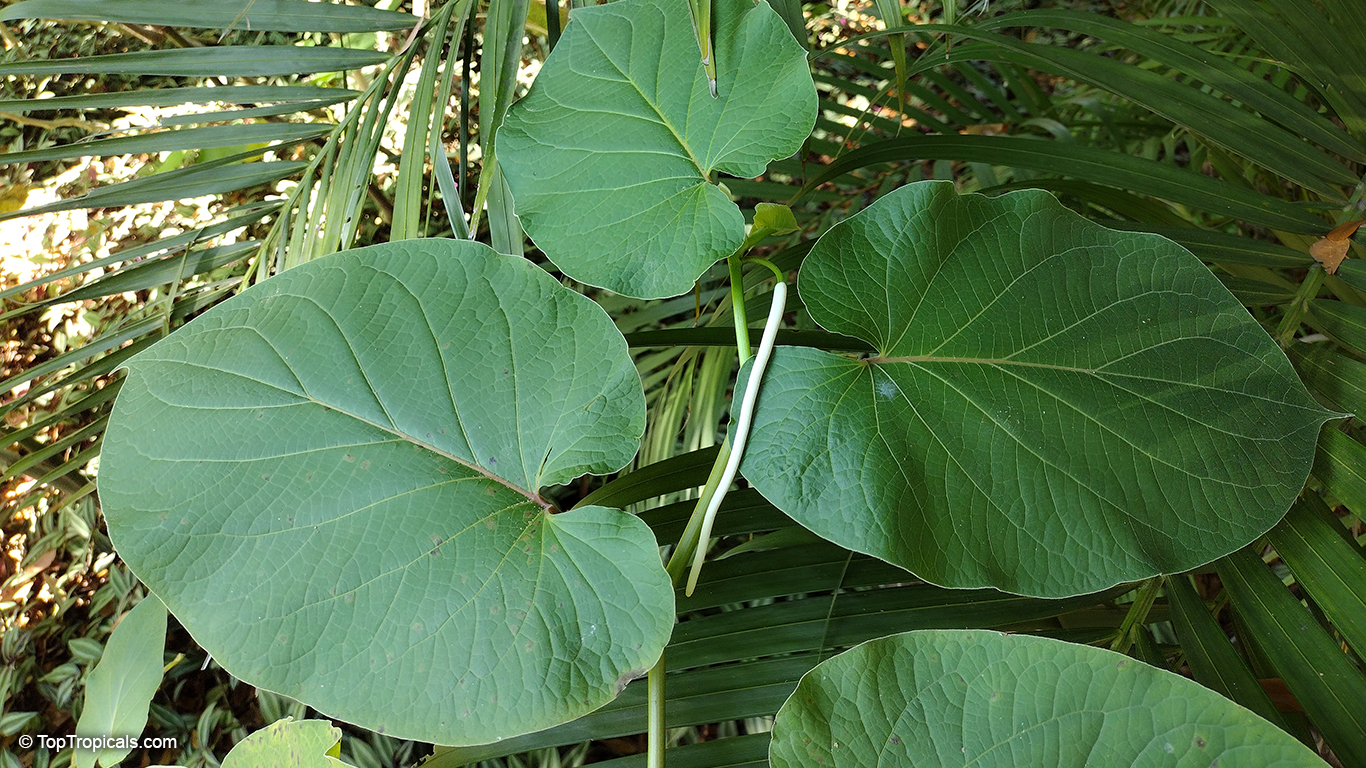
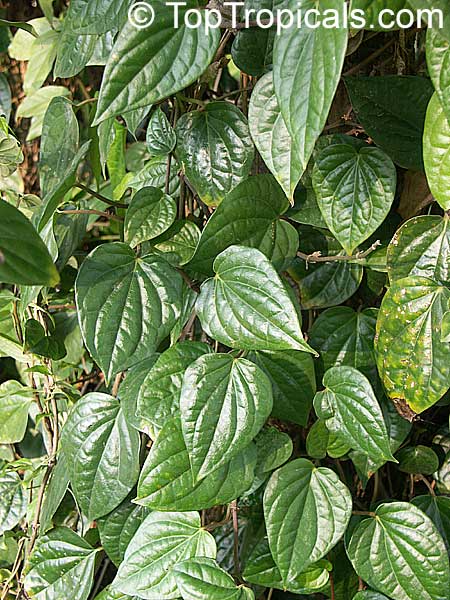
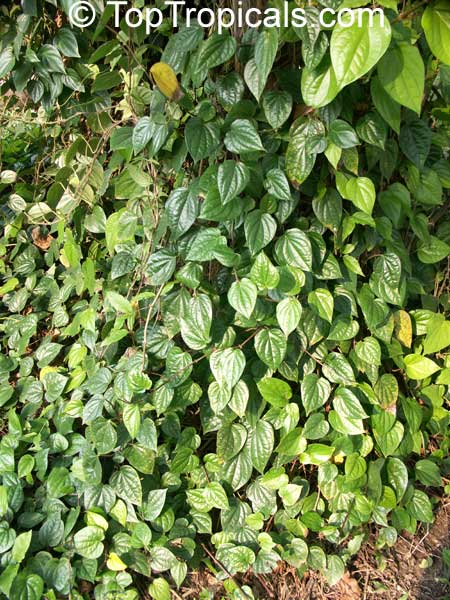
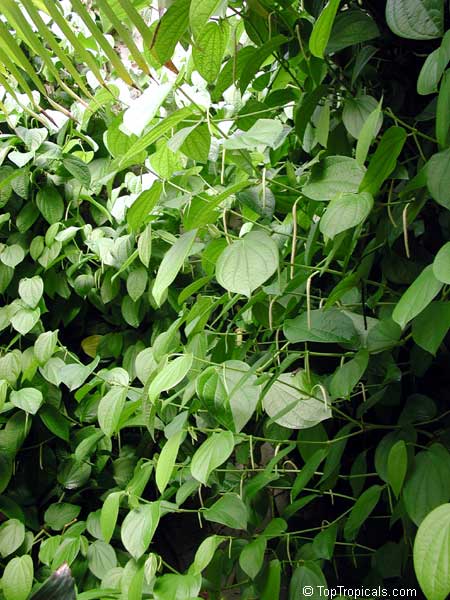
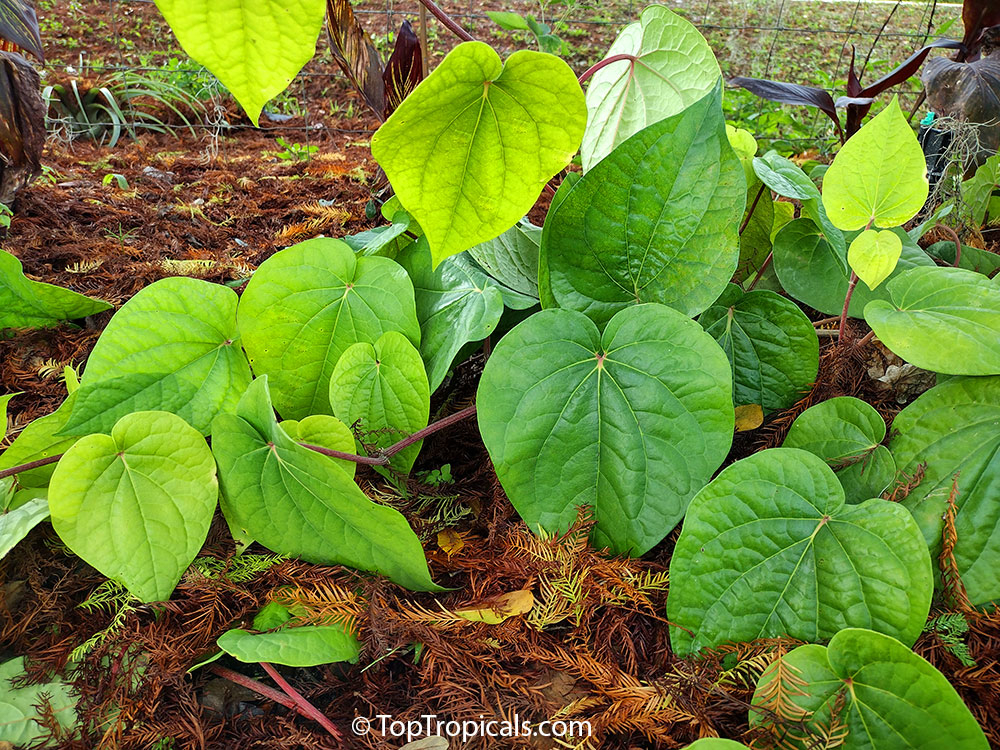
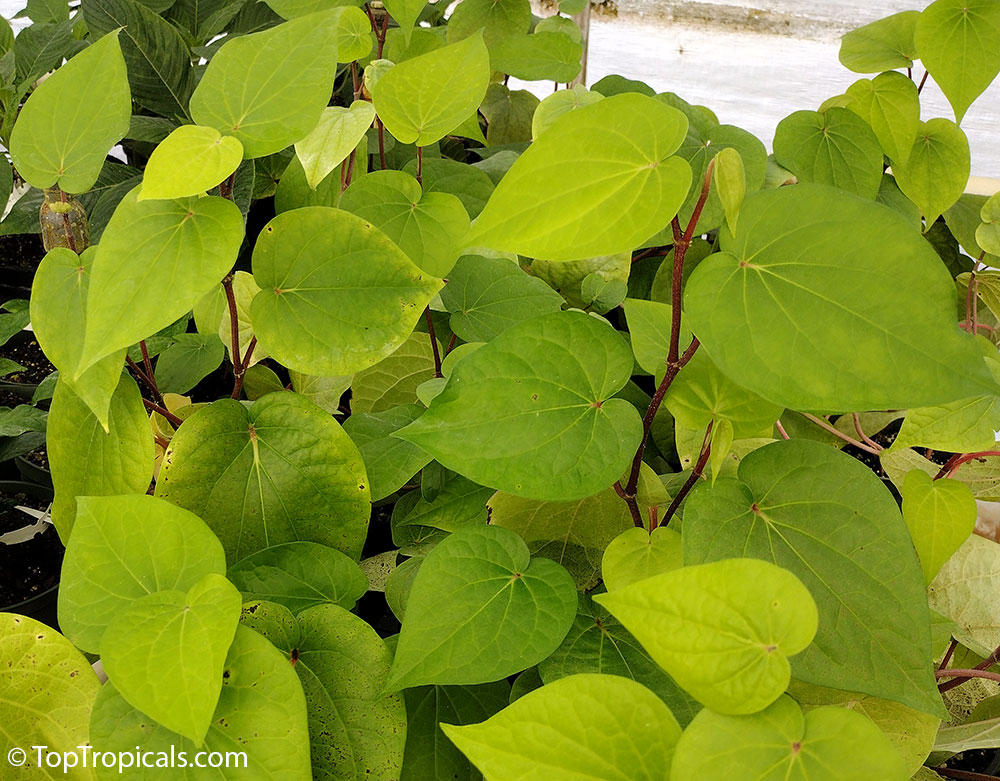
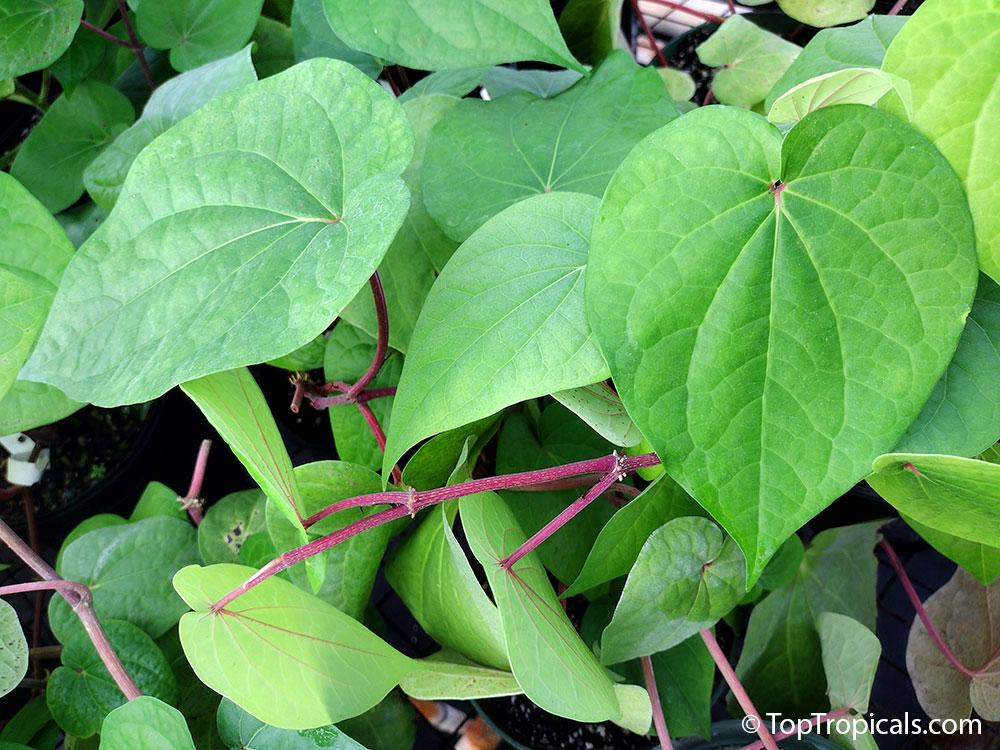
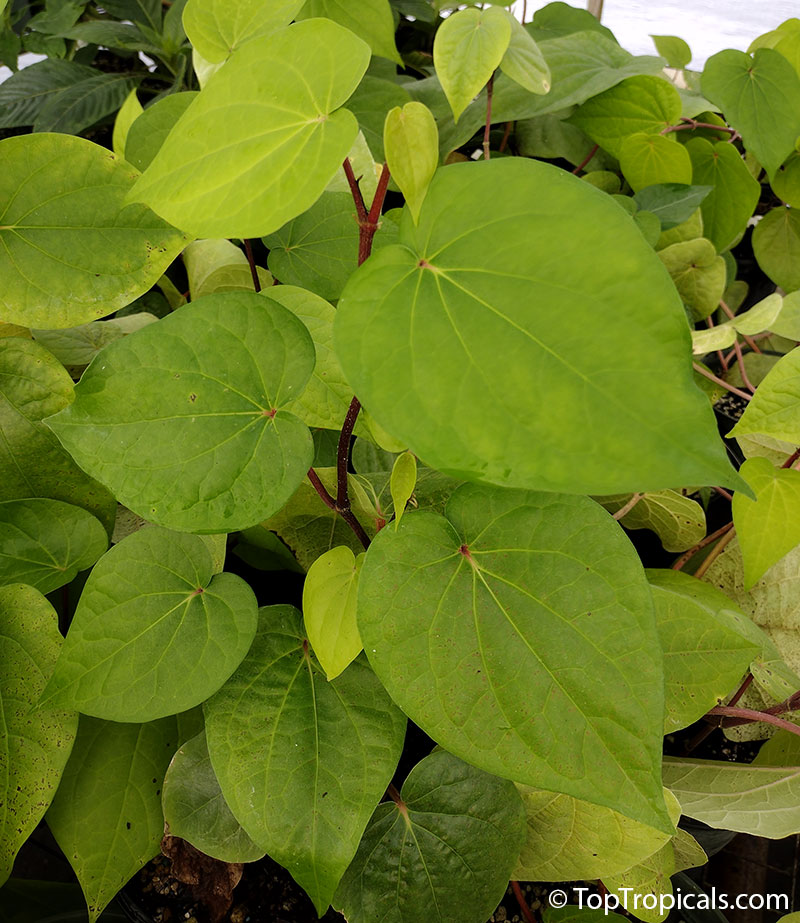
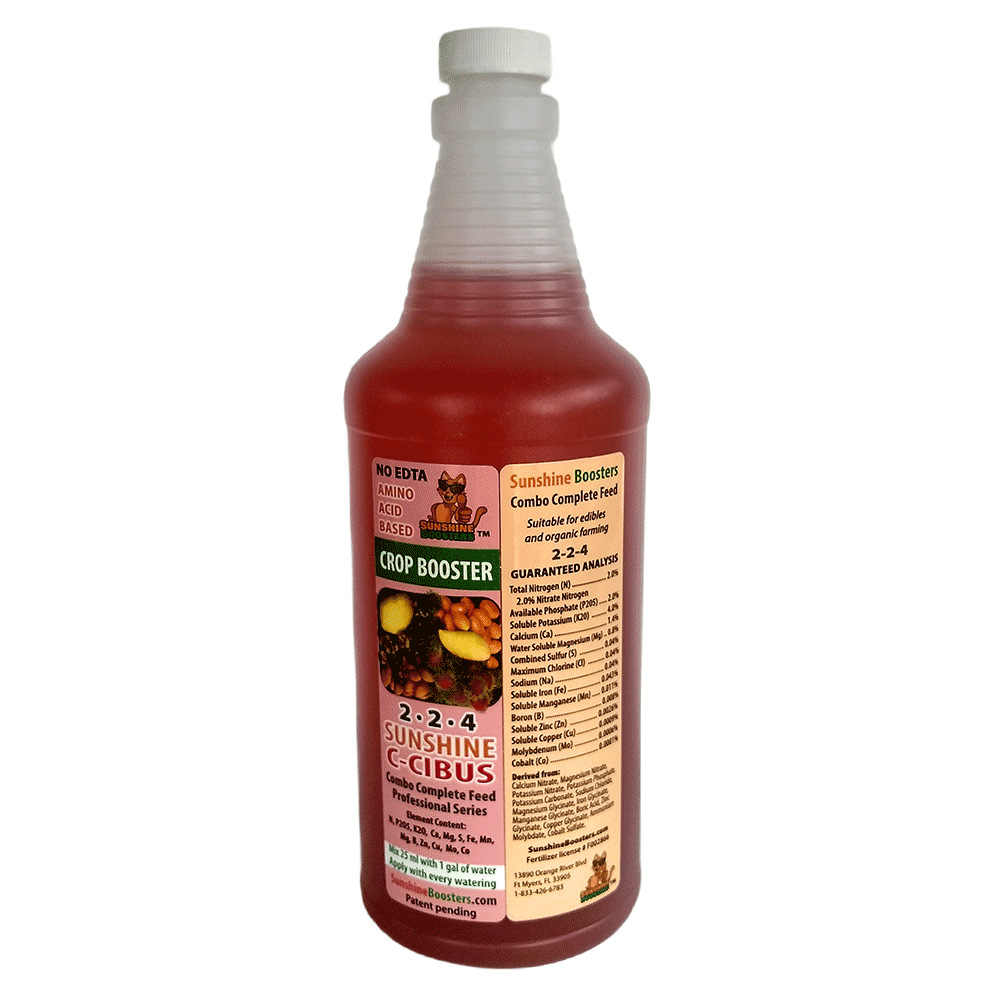 SUNSHINE C-Cibus (NPK 2-2-4) - Crop Booster for every watering.
SUNSHINE C-Cibus (NPK 2-2-4) - Crop Booster for every watering. 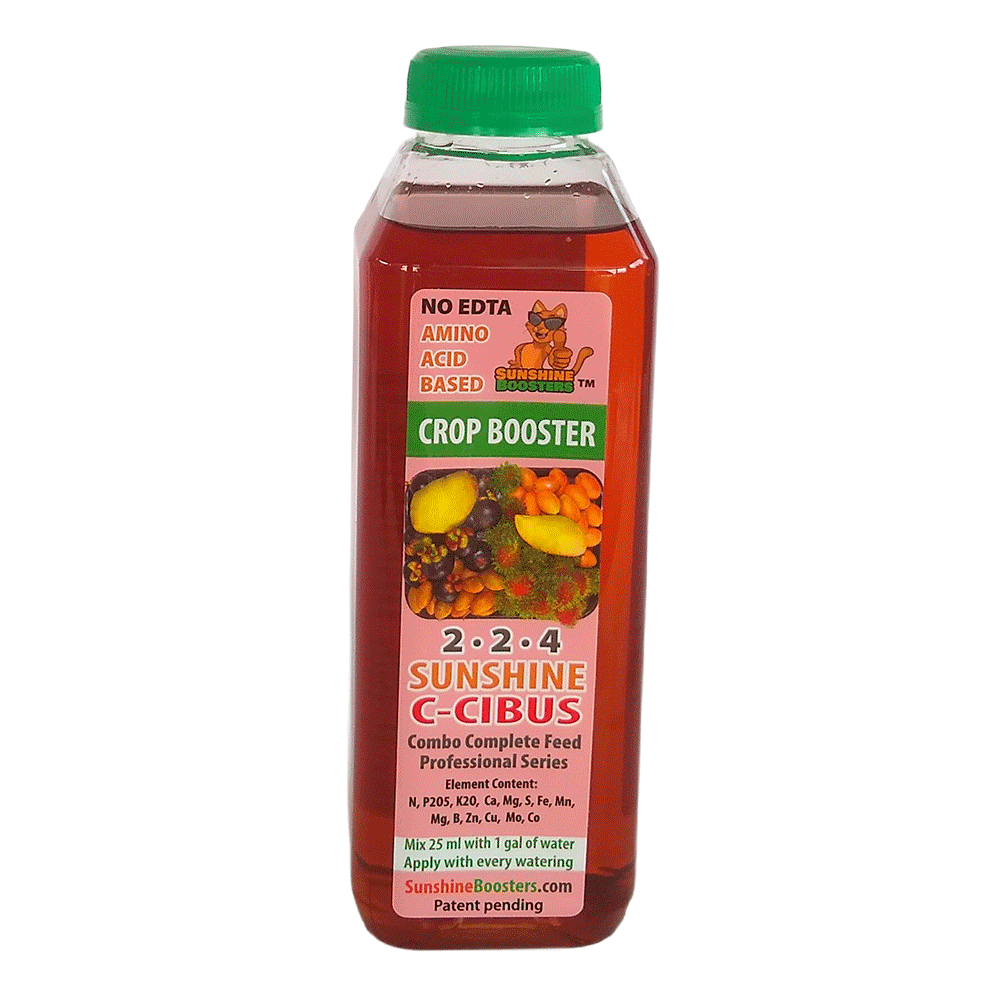 SUNSHINE C-Cibus (NPK 2-2-4) - Crop Booster for every watering.
SUNSHINE C-Cibus (NPK 2-2-4) - Crop Booster for every watering. 